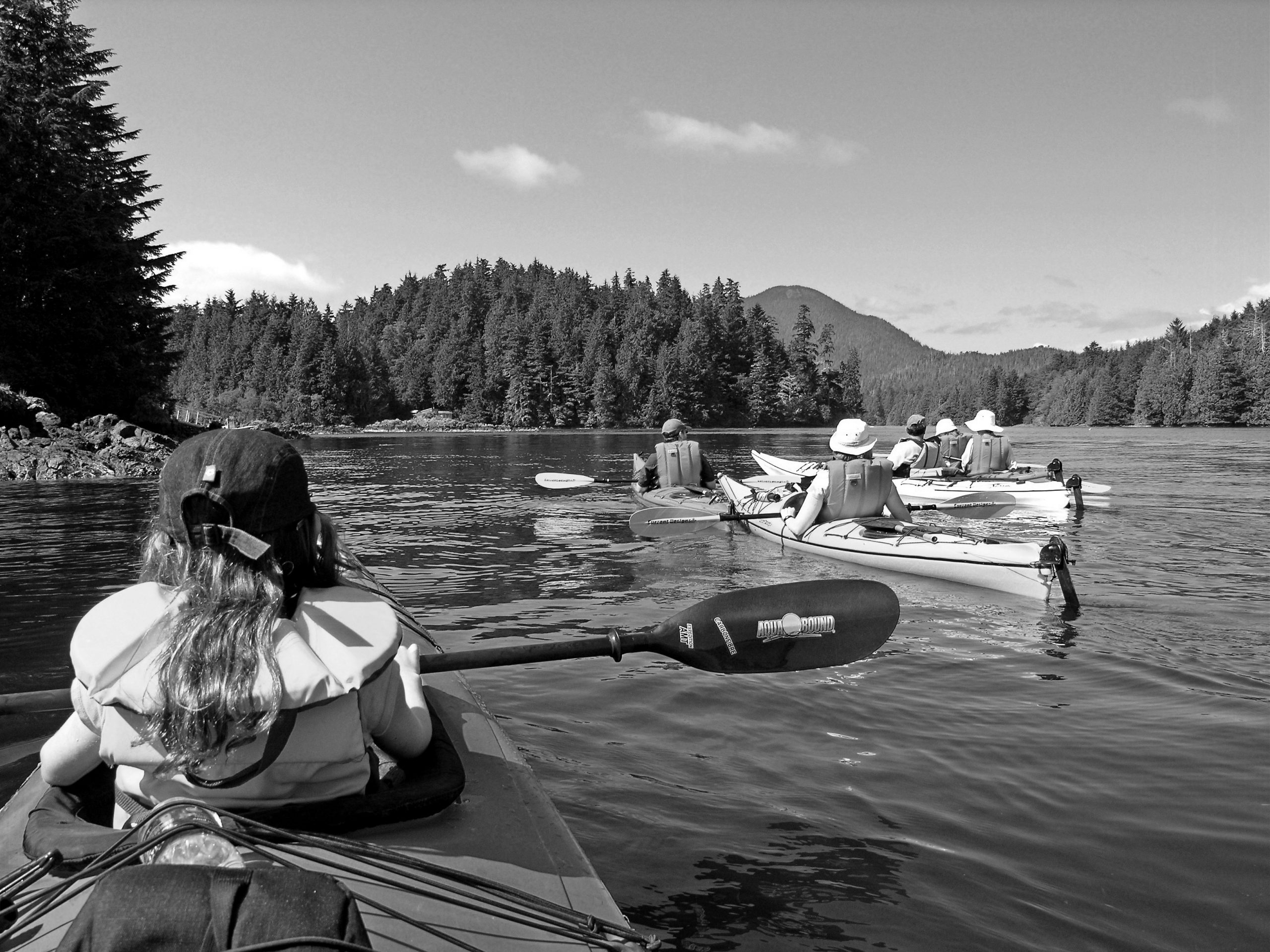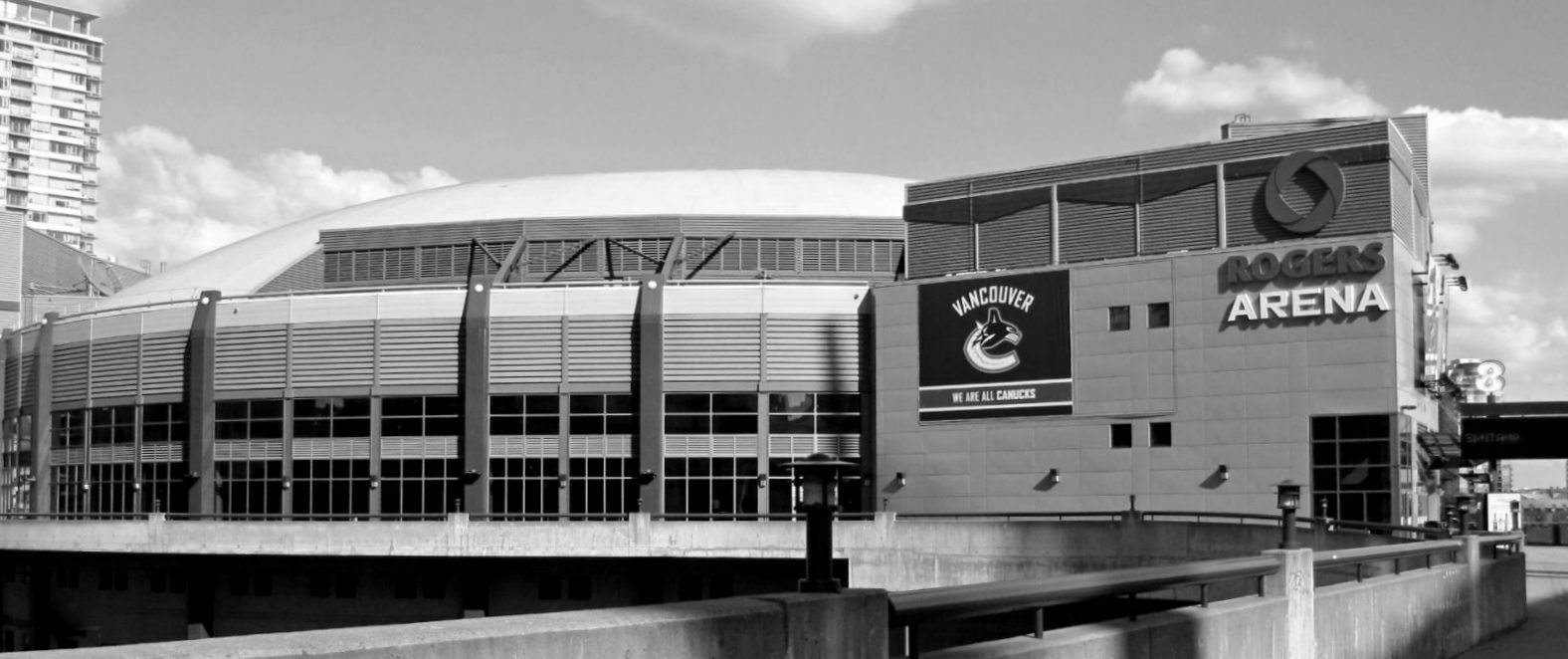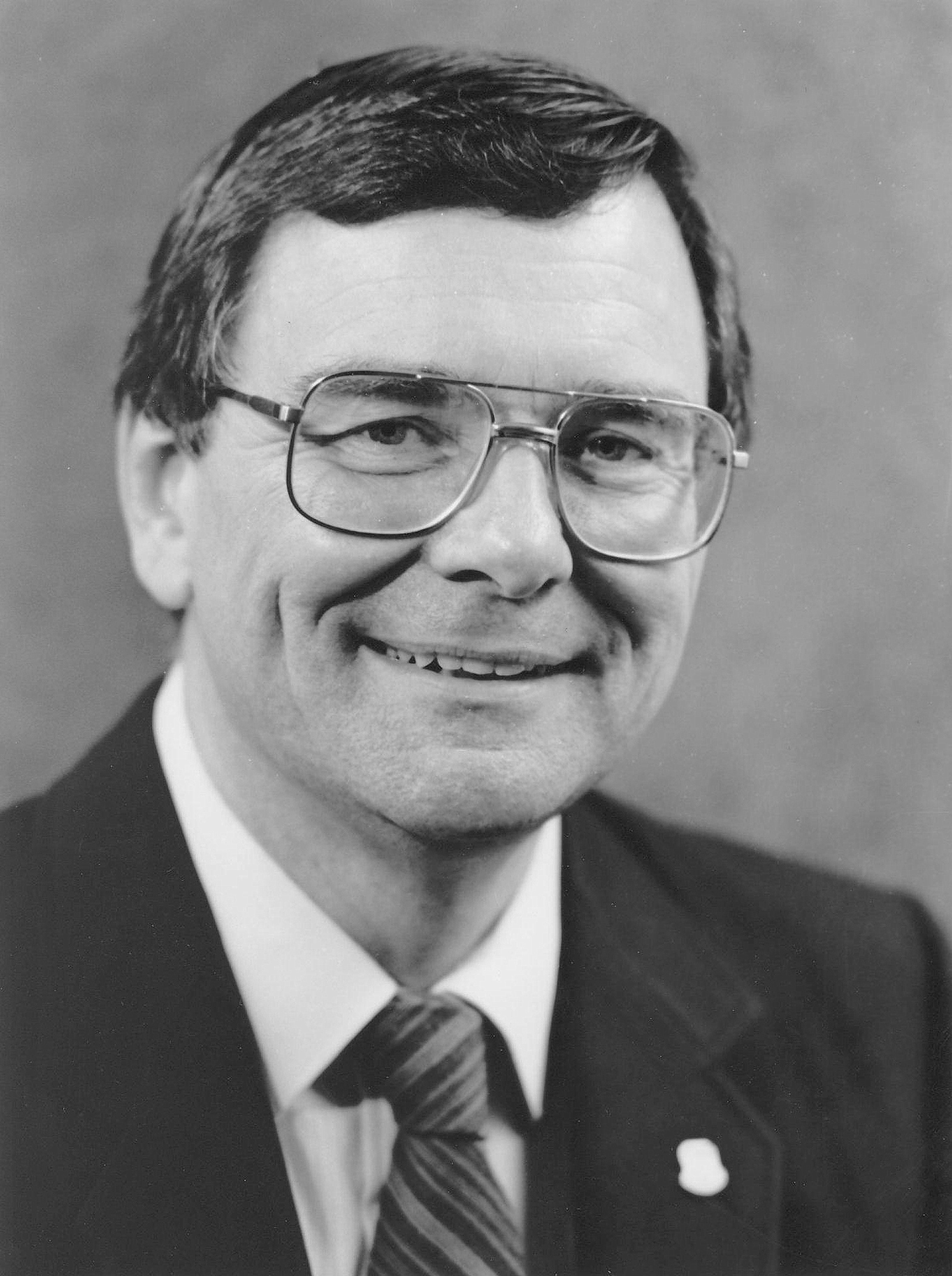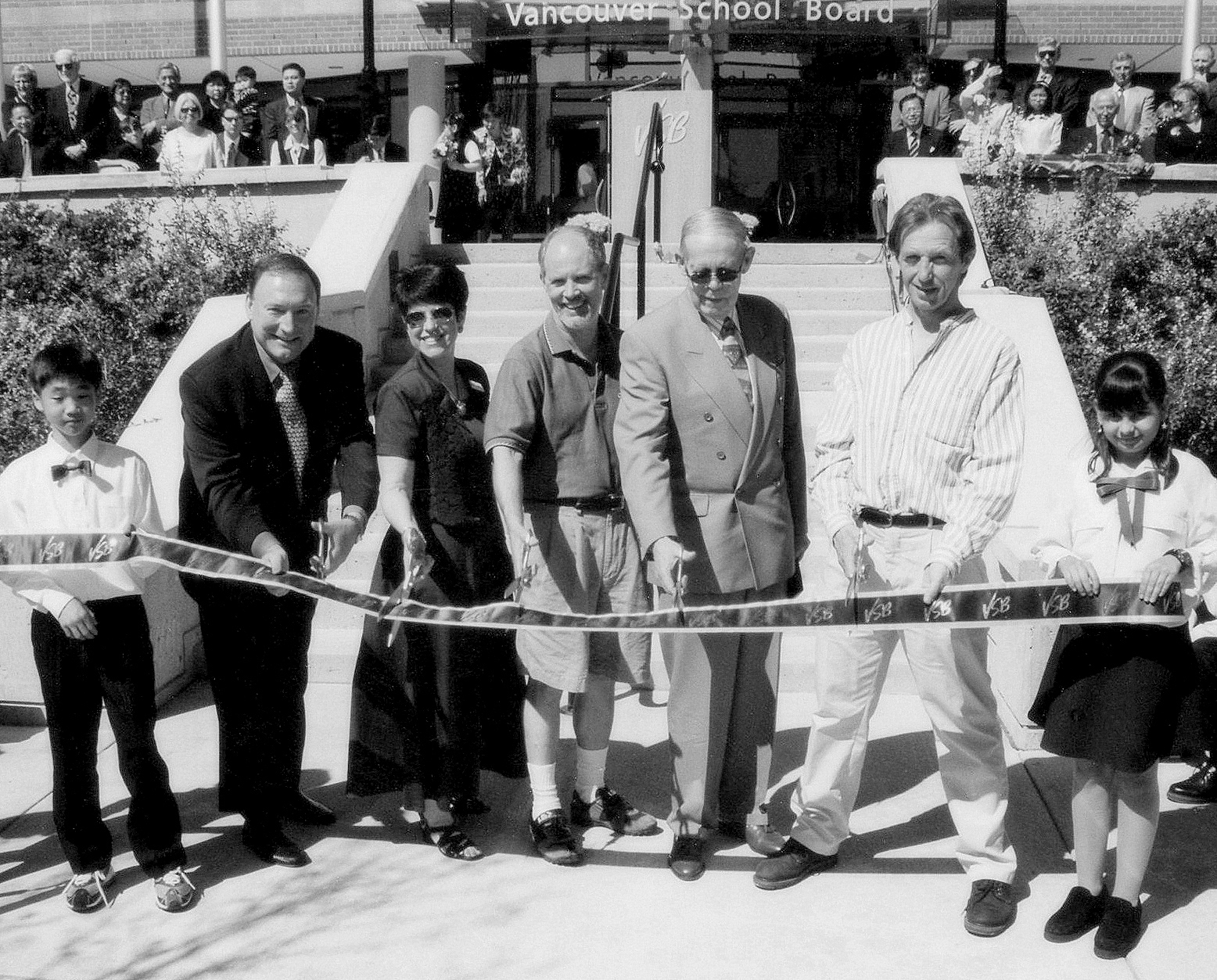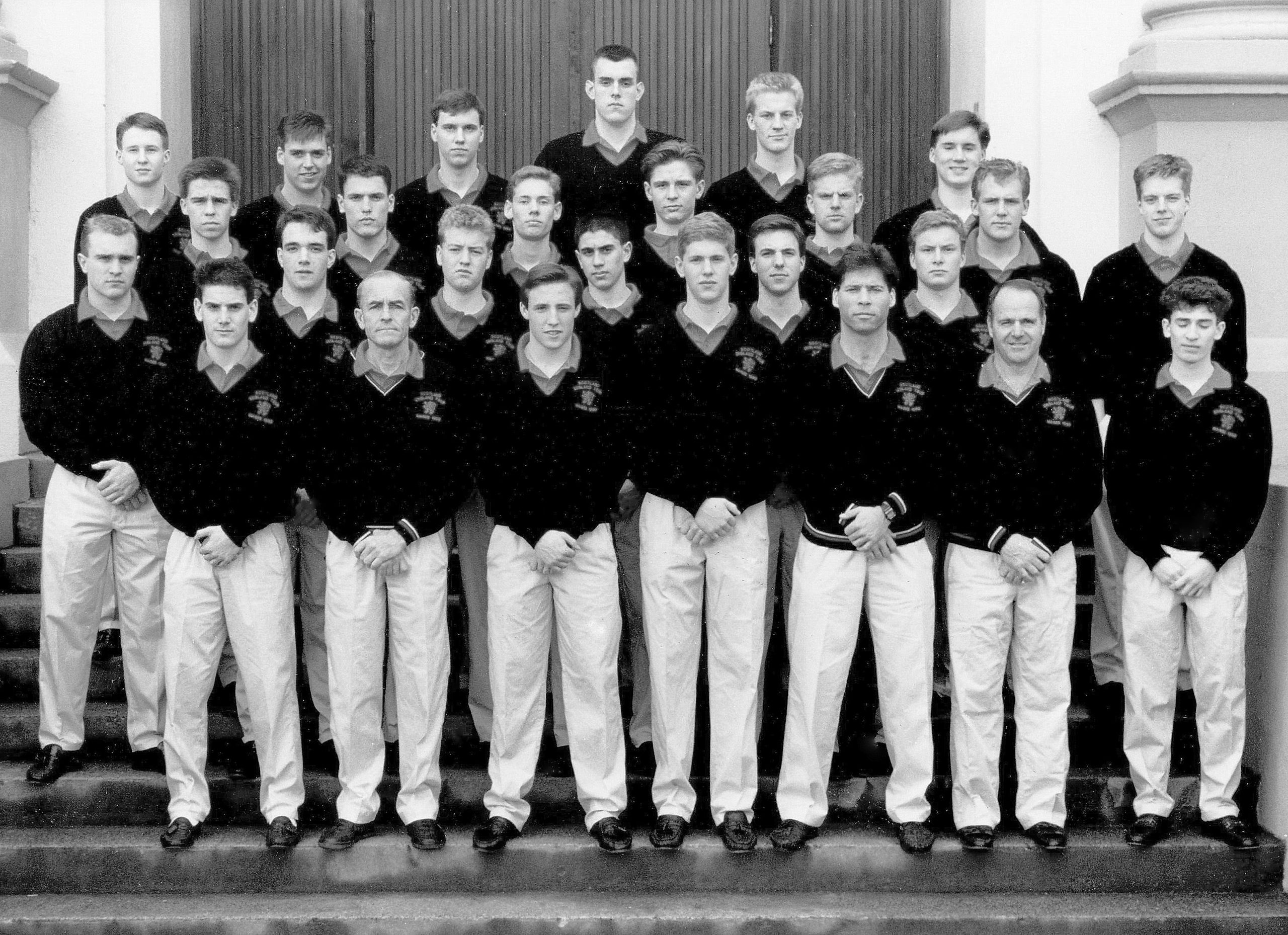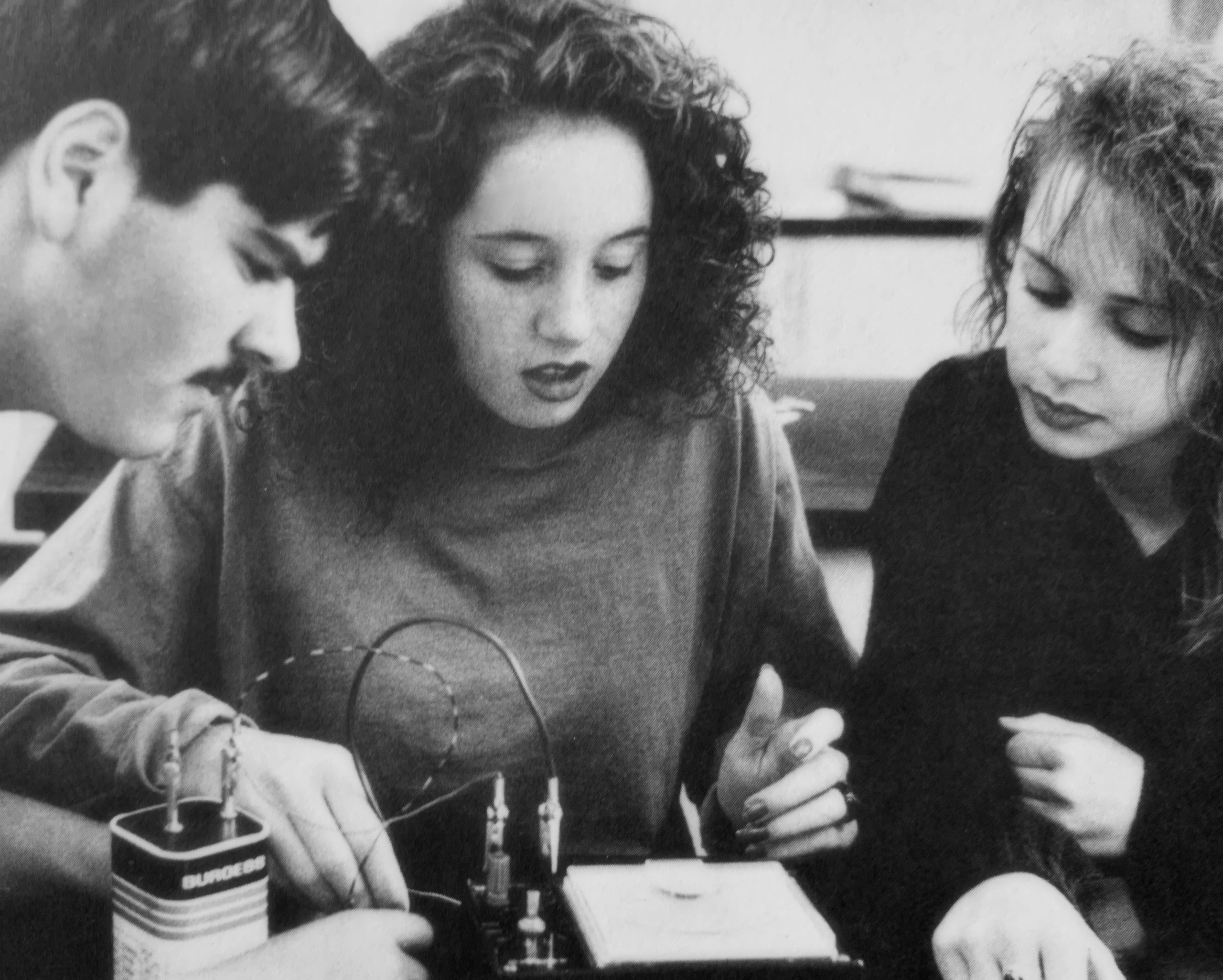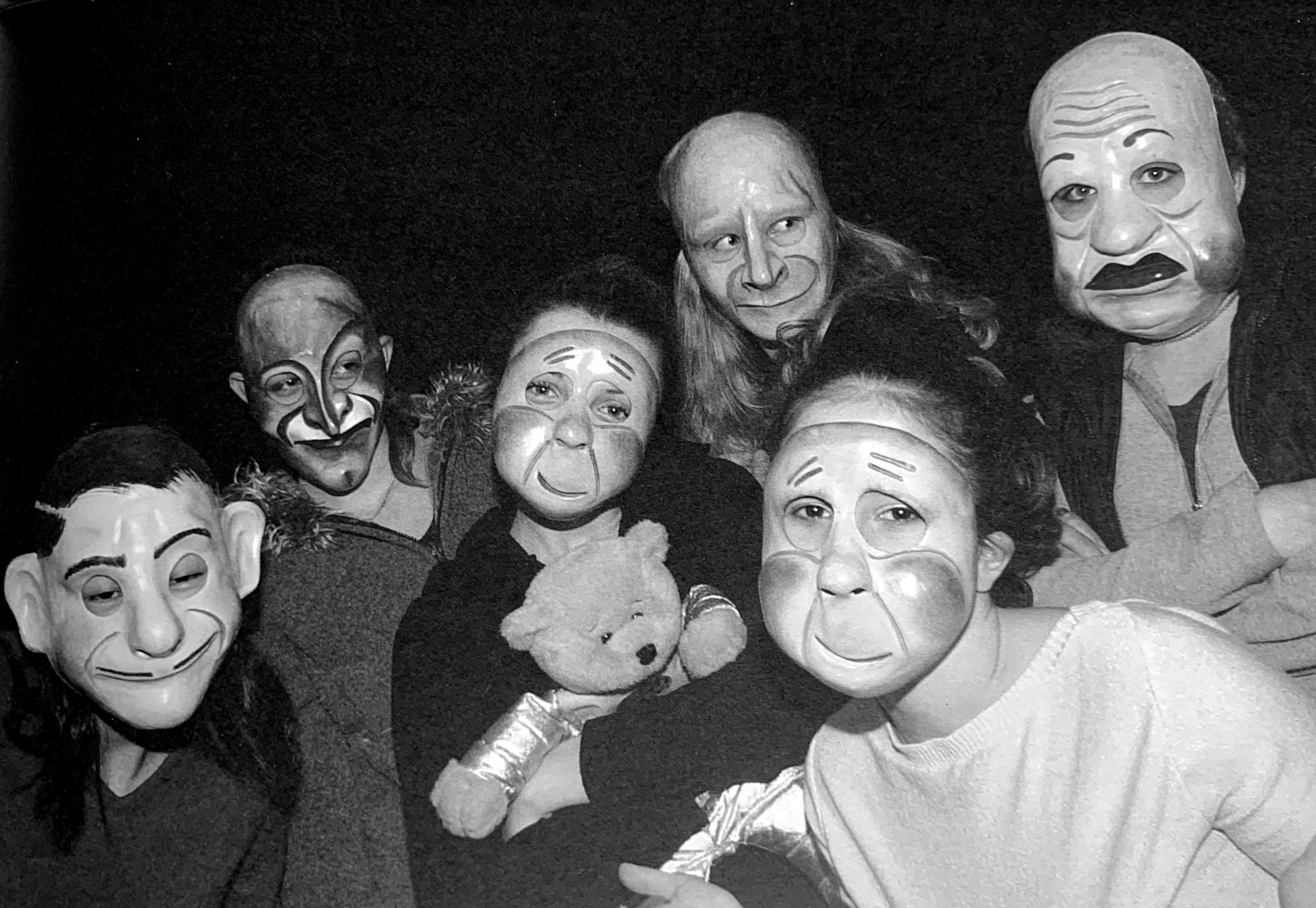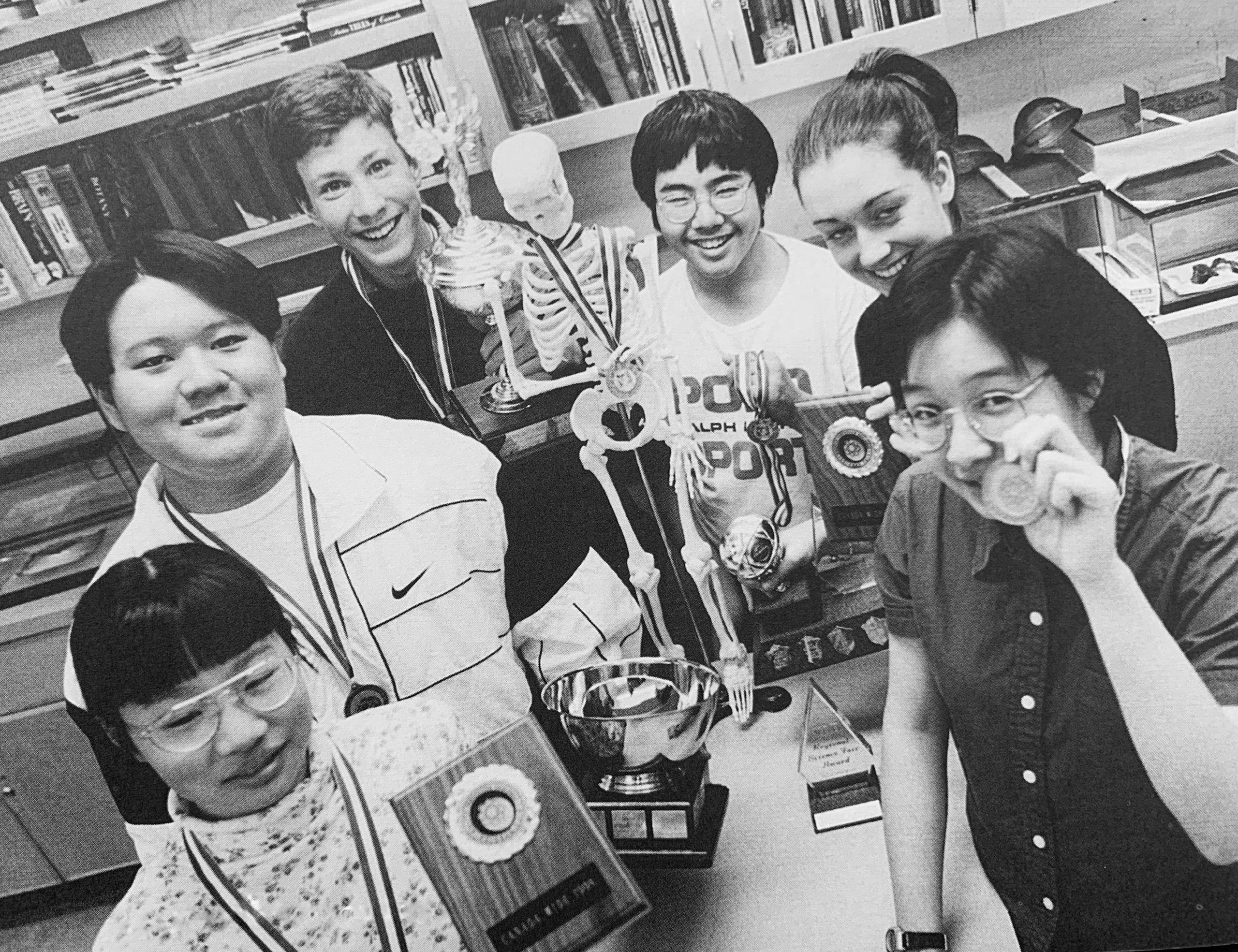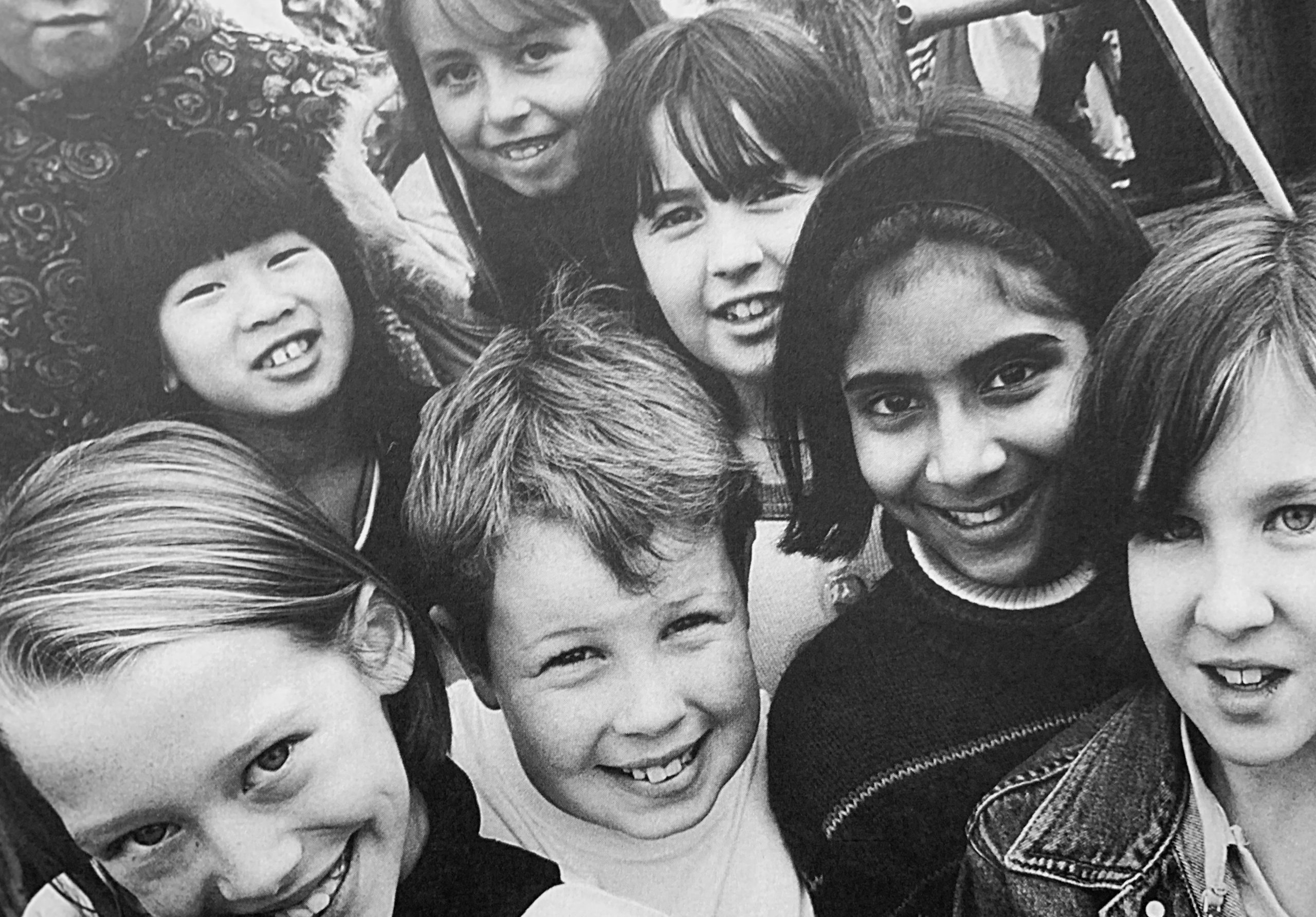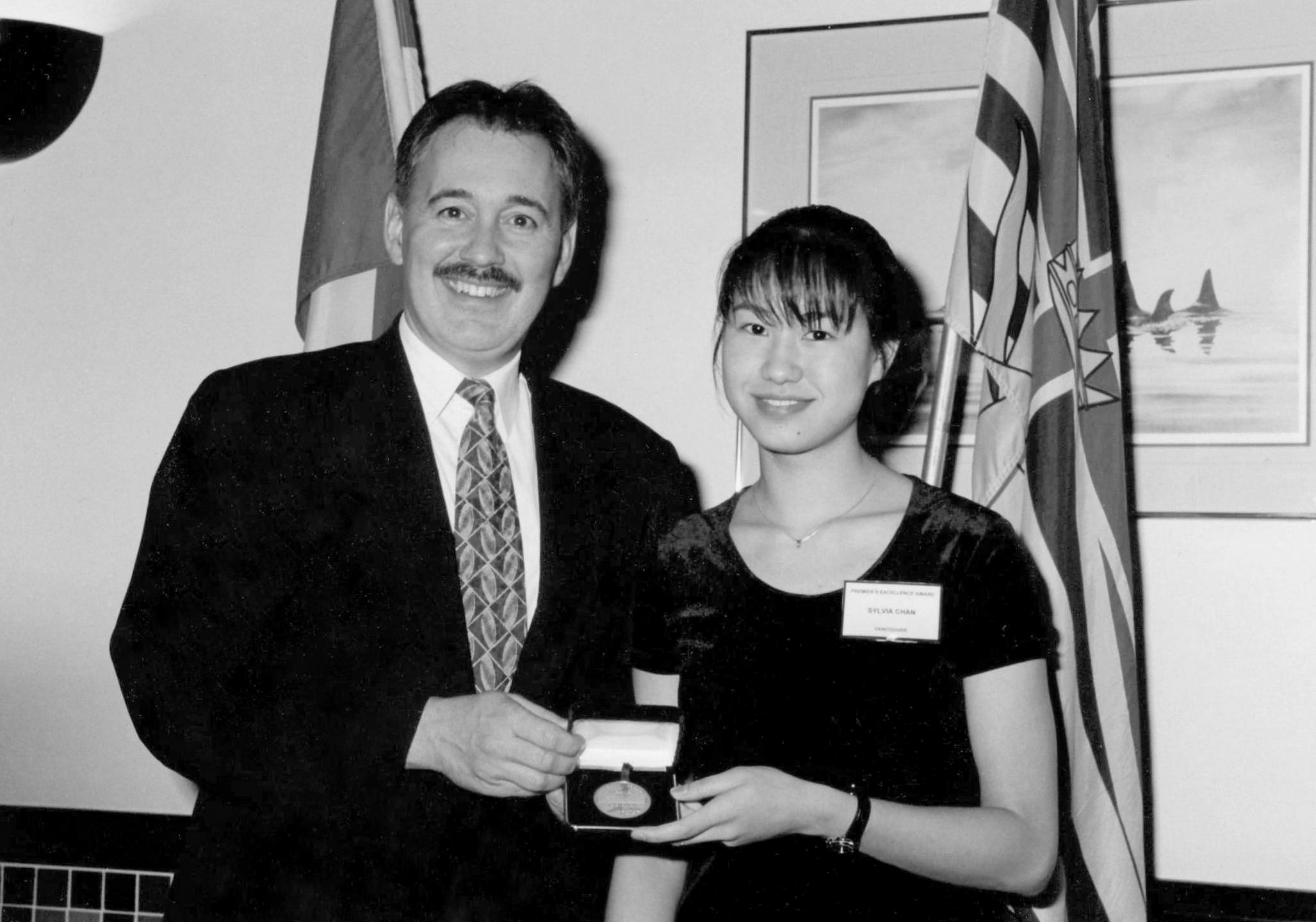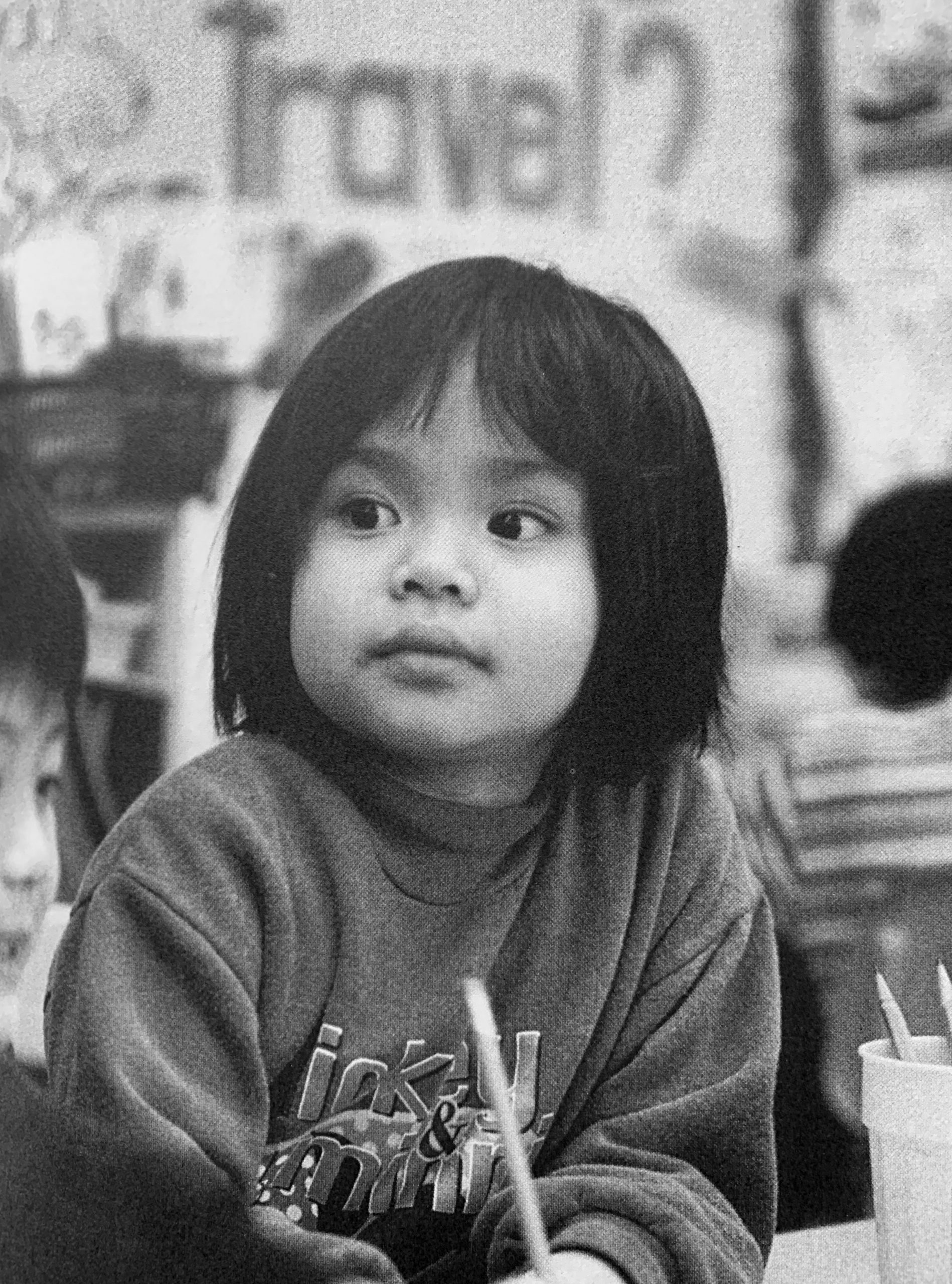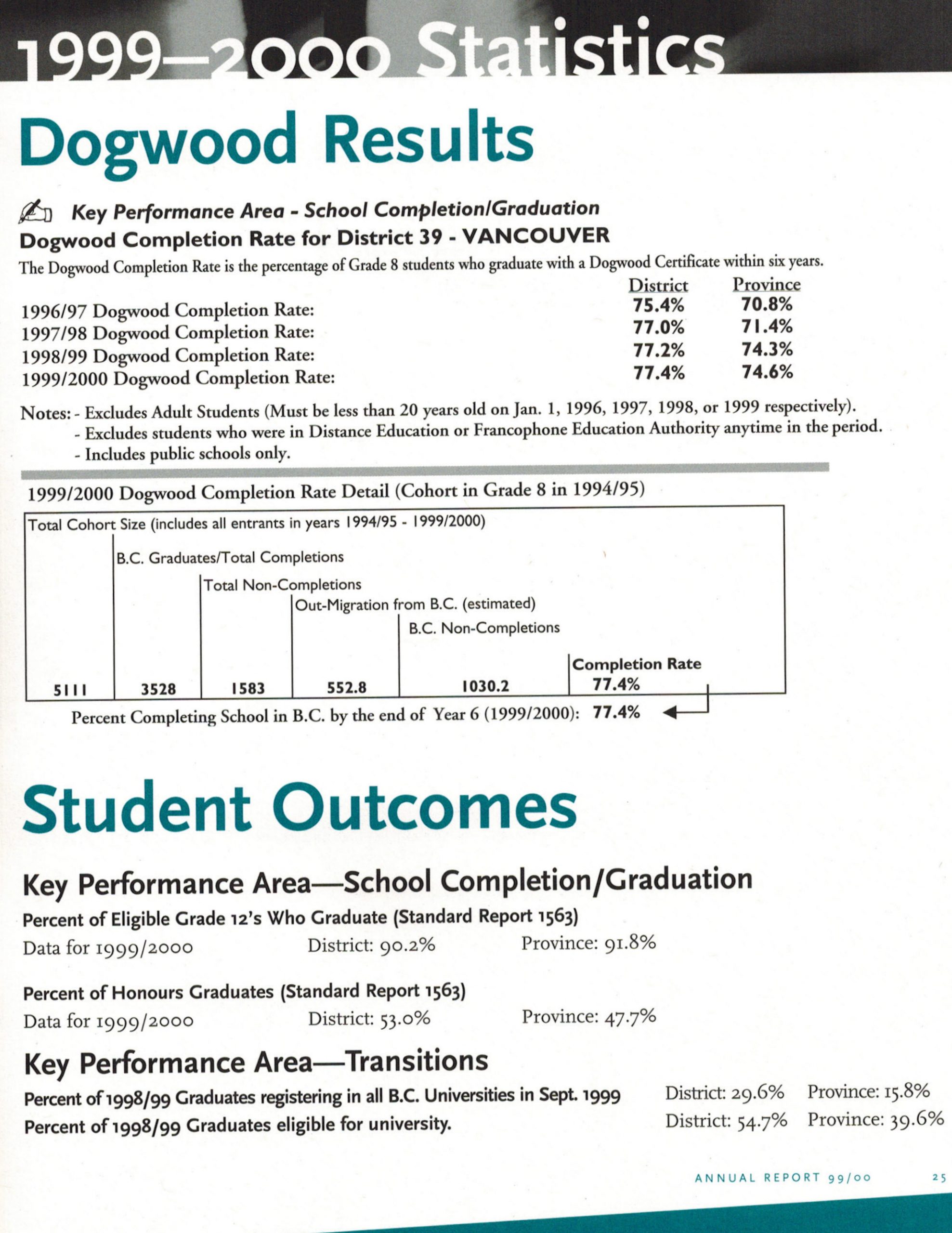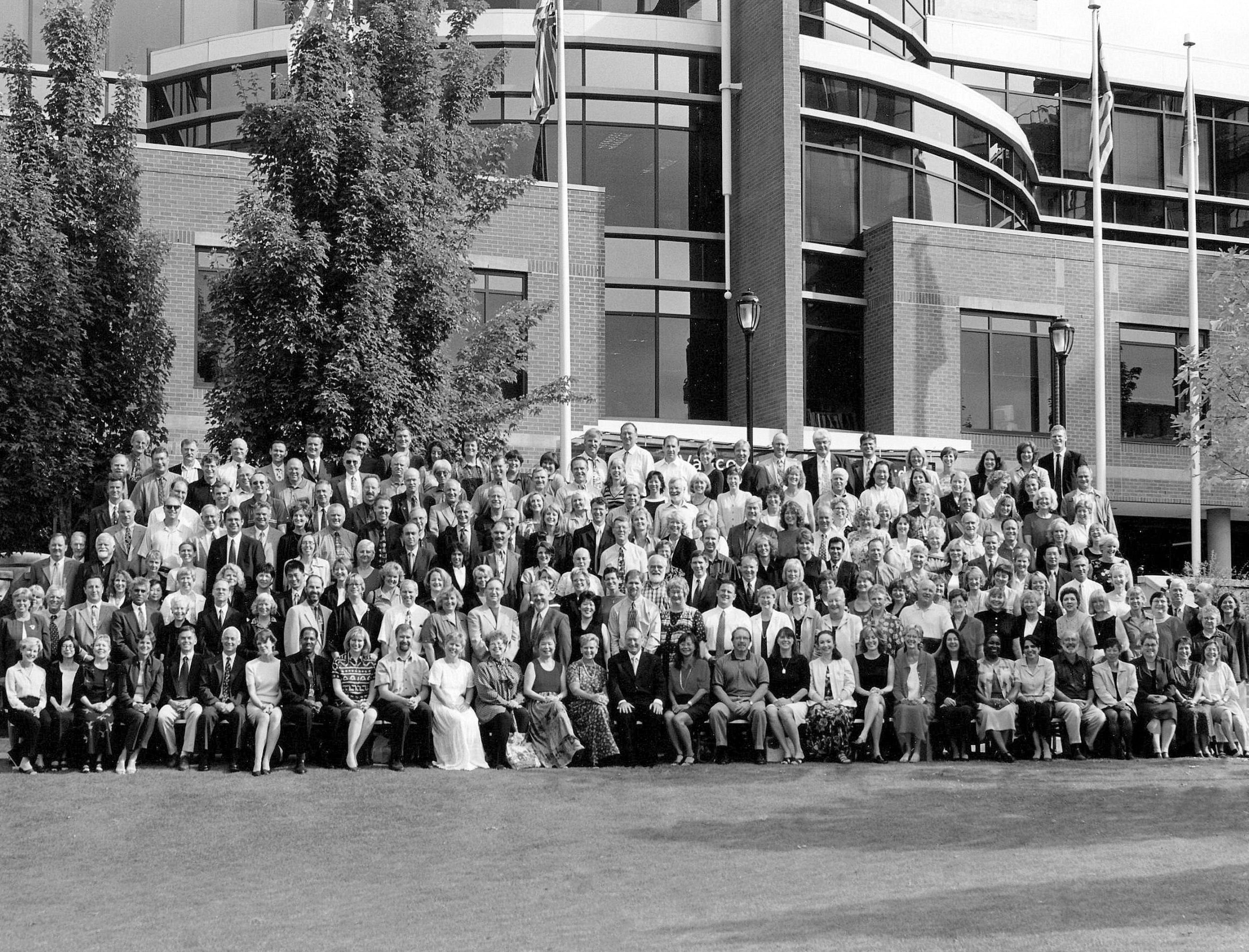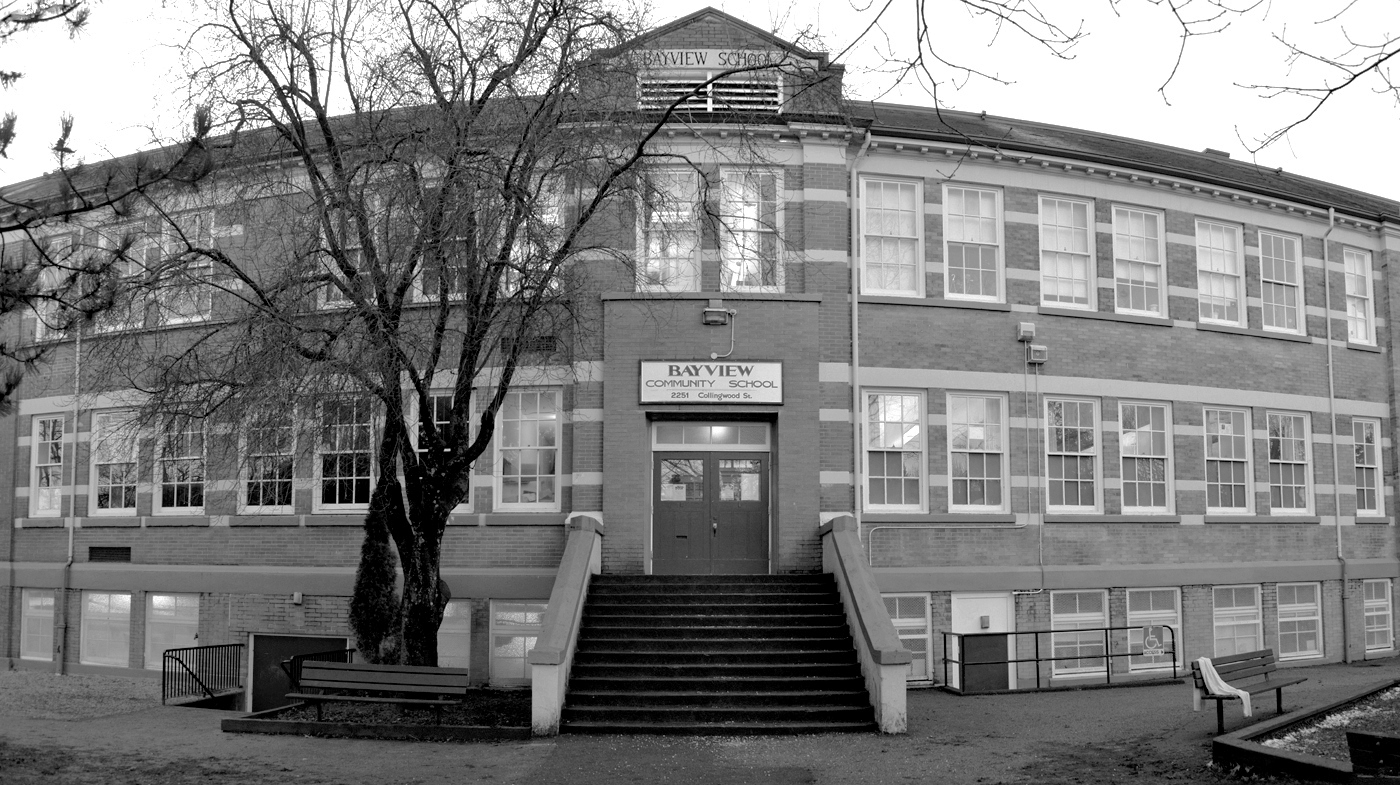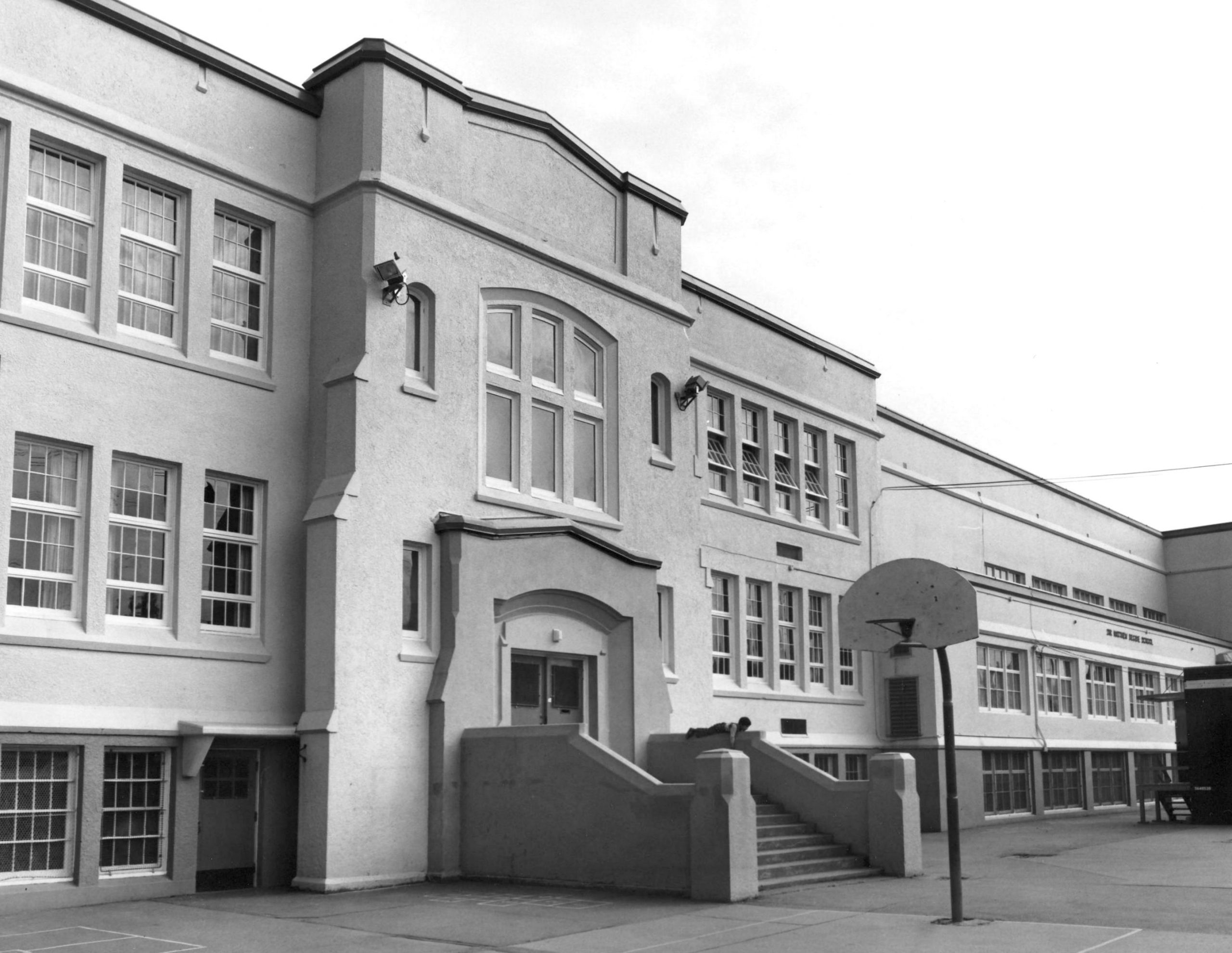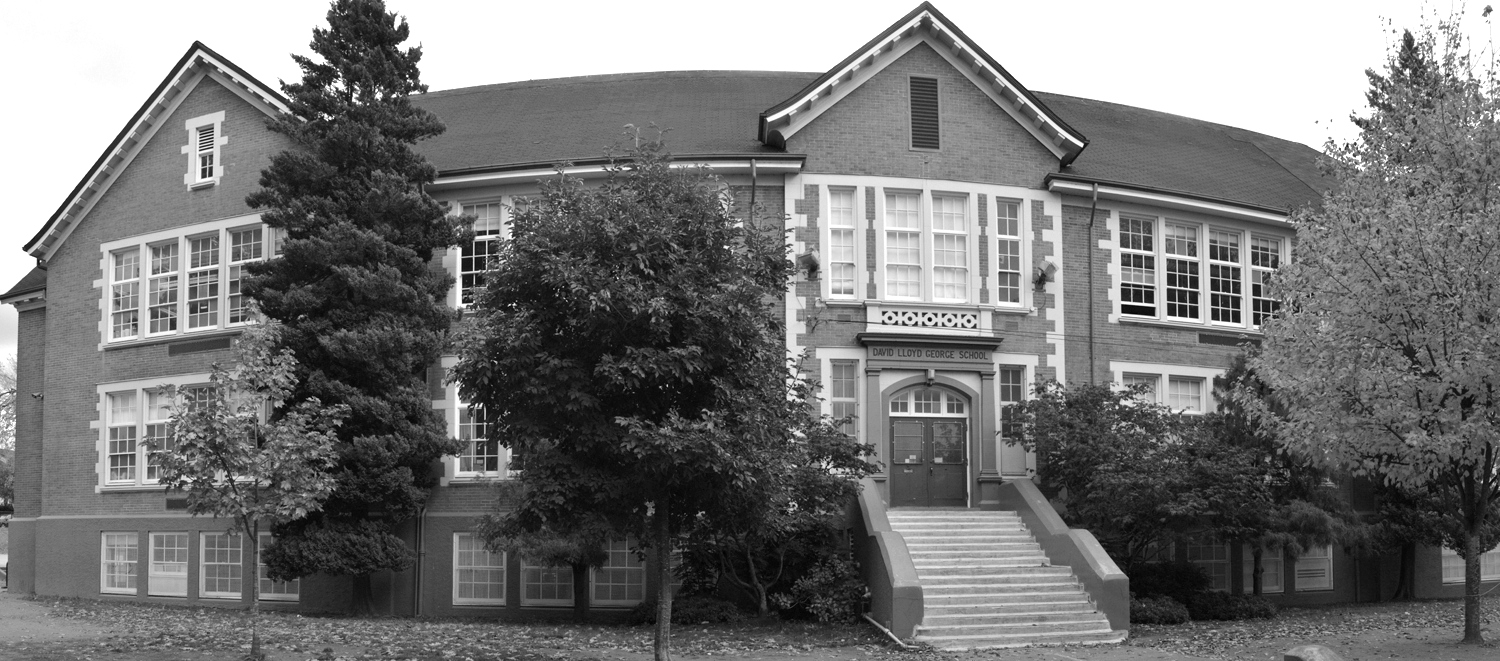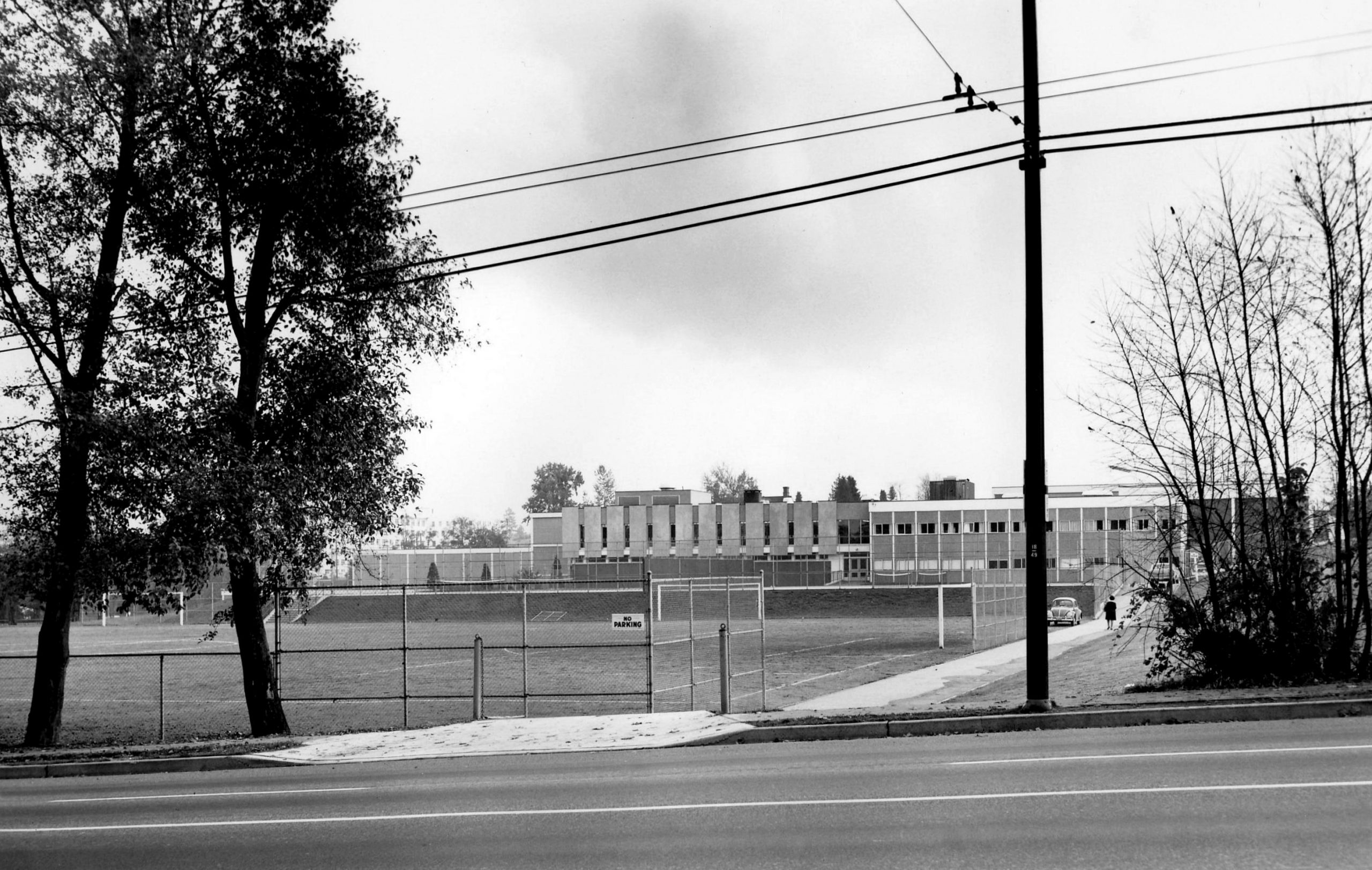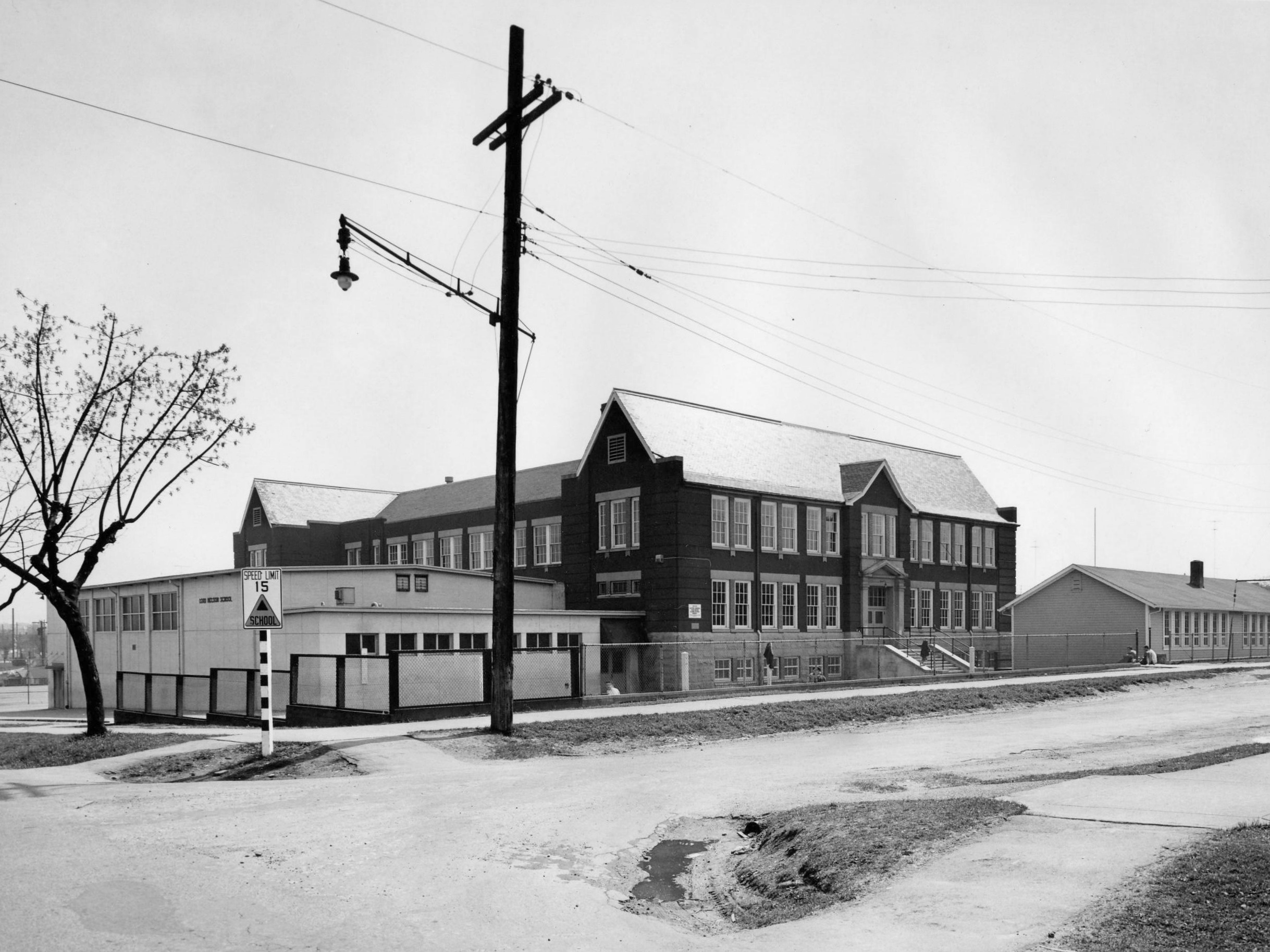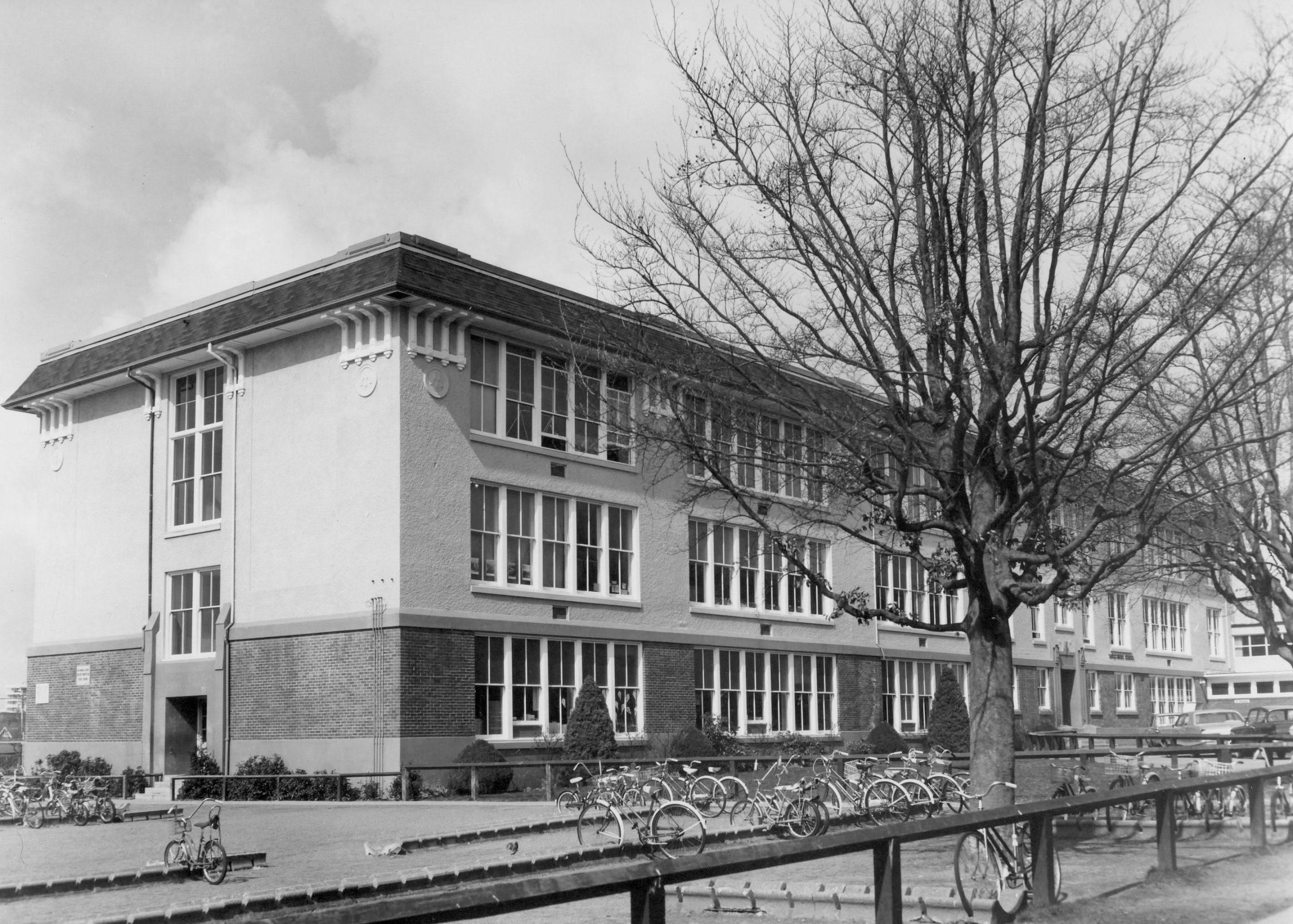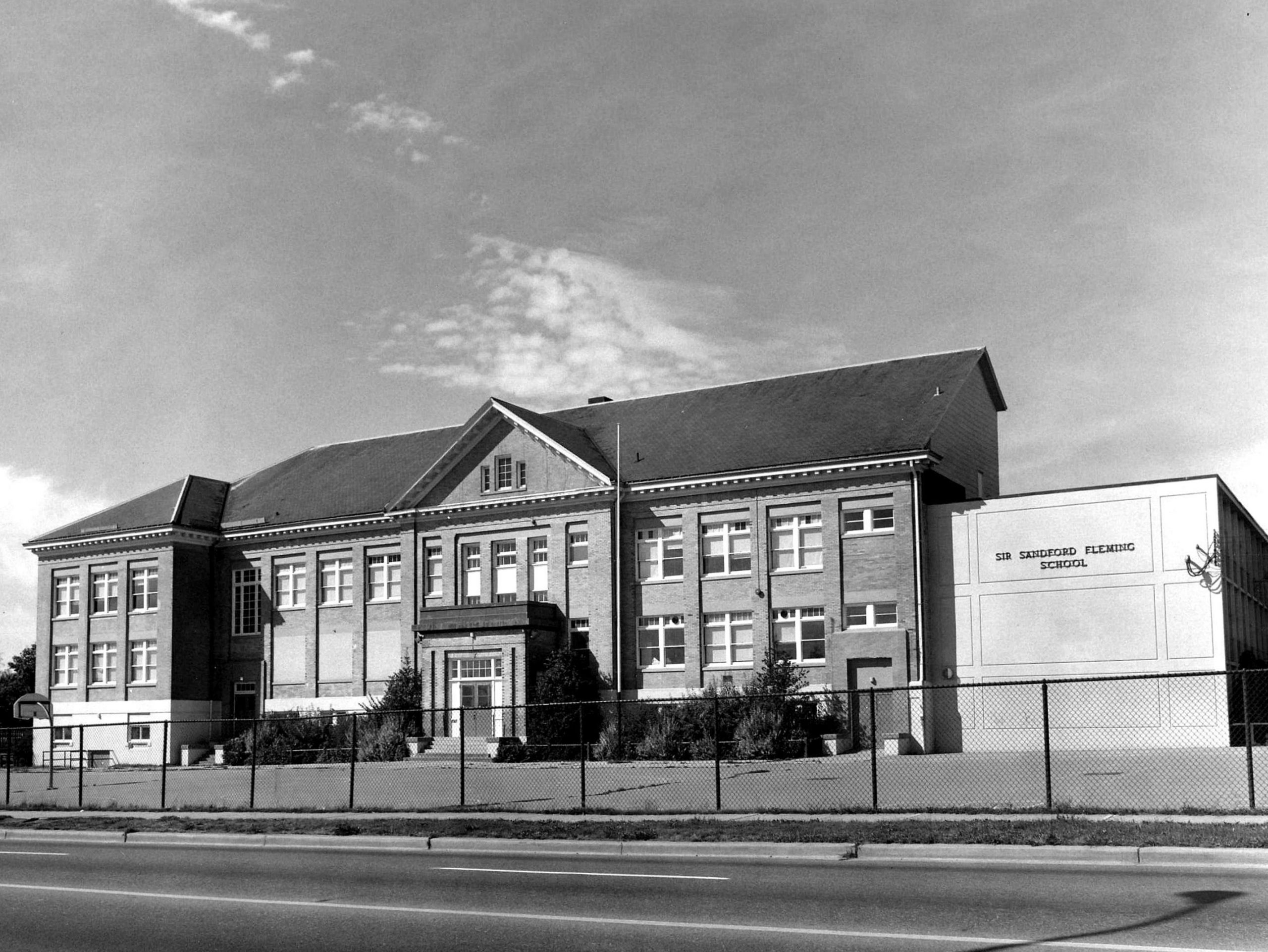Chapter Nine – The Nineties
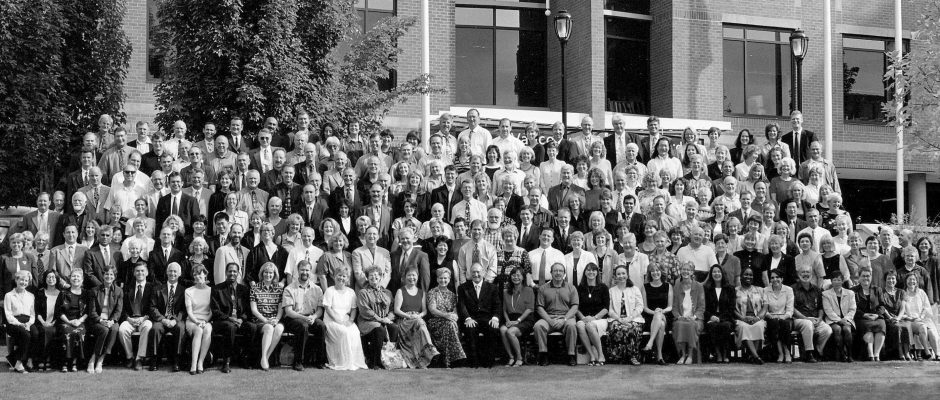
VSB personnel pose outside new Vancouver School Board building (1999)
I. INTRODUCTION
Setting the stage – An outline of major events in the World, Canada, British Columbia, and Vancouver.
A. THE WORLD
Clockwise from top left: Desert Storm battlefield, World Wide Web icon, Sarajevo (Boznia and Herzegovina), Rwanda memorial.
1990 West Germany and East Germany unite after 45 years of separation.
1991
An American-led international force launches Operation Desert Storm – a military assault against Iraq.
The World Wide Web is launched.
The Soviet Union collapses, due largely to radical reforms introduced by Soviet president Mikhail Gorbachev.
1992 US President Bush and Russian President Boris Yeltsin proclaim a formal end to the Cold War.
1993 Devastating riots break out in Los Angeles after three Los Angeles police officers are acquitted of the beating of Rodney King, a Black activist.
1994 The Rwandan Genocide ends after lasting 100 days, leaving an estimated 800,000 people dead.
Nelson Mandela is elected as South Africa’s first black president.
1995 Leaders from Serbia, Bosnia and Herzegovina, and Croatia sign the Dayton Accord on December 14, ending 43 months of genocidal warfare.
1996 Dolly the Sheep, the first cloned mammal, is born.
1997
Diana, Princess of Wales is killed in an automobile crash in Paris, France.
Hong Kong is returned to China, ending 156 years of British rule.
1998
President Bill Clinton is impeached on grounds of perjury and obstruction of justice, but is not convicted by the US Senate.
1999 The euro makes its debut as the European currency.
B. CANADA
During the 1990s, one of the most significant developments in Canada was the continuation of the Treaty process with Indigenous peoples. This map records the agreements from 1977 t0 2016.
1990 On July 11, a standoff begins at Oka, Quebec when police attempt to storm a barricade erected by the Mohawk to block expansion of a golf course onto land they claim is theirs.
1991 Canadian CF-18 jet fighters fly an offensive mission in the Persian Gulf war, marking the first time Canadian forces have engaged in battle since the Korean War.
1992 Federal Fisheries Minister John Crosbie announces a two-year shutdown of Newfoundland’s northern cod fishery due to dwindling cod stocks.
1995 On October 30, Quebec holds its second sovereignty referendum in 15 years. The “no” side wins with a 50.6% majority in a vote where 93.2% of the population cast a ballot.
1996 The House of Commons approves changes to the Canadian Human Rights Act to prohibit discrimination against gays.
1998 On August 04, a treaty gives the Nisga’a First Nation ownership of 2,000 square kilometres in northern British Columbia.
1999 On April 01, Nunavut becomes Canada’s third territory.
Immigration Policy
1990 The government unveiled its Five Year Plan for immigration, proposing an increase in total immigration from 200,000 in 1990 to 250,000 in 1992. The long term commitment to planned immigration was new in Canadian history, as was the proposal to increase immigration at a time of economic recession.
1992 Bill C-86 was tabled. The bill proposed revisions to the refugee determination system, mostly restrictive. The first level screening process with the credible basis test was abandoned and “eligibility” determinations transferred in part to immigration officers. Proposed measures included increased powers to immigration officers, harsher detention provisions and making refugee hearings open to the public (these were amended as the bill passed through Parliament). New grounds of inadmissibility were added. (Bill C-86 came into effect in 1993.)
1993 The Chairperson of the Immigration and Refugee Board issued Guidelines on Women Refugee Claimants fearing Gender-related Persecution. Canada was the first country in the world to issue such guidelines. Non-governmental organizations including the Canadian Council for Refugees were active in drawing attention to the need for gender sensitivity.
1998 The governments of British Columbia and Manitoba signed agreements with the federal government giving these provinces responsibility for the administration of settlement services.
C. BRITISH COLUMBIA
During the 1990s, an unprecedented number of persons served as Premier of British Columbia. NDP premiers led the BC government from November 1991 to the end of the decade.
Bill Vander Zalm, Social Credit Party (1986 – 1991)
Rita Johnson, Social Credit Party (April 02, 1991 – November 05, 1991)
Mike Harcourt, NDP (1991 – 1996)
Glen Clark, NDP (1996 – 1999)
Dan Miller, NDP (1999 – 2000)
The economy struggled for much of the decade due in part to a weak demand for the products of the forestry and mining industries. One bright spot was the growth of the tourist industry.
The 1990s also saw the rise of a powerful environmental movement in British Columbia. In 1993, more than 850 protesters were arrested for blockading logging roads leading into old growth forests bordering Clayoquot Sound on the west coast of Vancouver Island. This was the most prominent of many protests throughout British Columbia aimed at preventing the logging of old growth forests. In a number of instances, the protests were led by Indigenous groups determined to protect land they claimed as their own.
Clayoquot Sound near Tofino, Vancouver Island.
British Columbia Ministry of Education
1990 The B.C. Home and School & Parent-Teacher Federation is replaced by the British Columbia Confederation of Parent Teacher Councils.
1993 The Ministry of Education is restyled Ministry of Education, Skills, and Training. The new ministry is responsible for all provincial education programmes, from kindergarten to Grade 12, and in the post-secondary sector (colleges and universities.)
1995 A First Nations curriculum is introduced in provincial secondary schools. Designed as an elective course for Grade 12 students, the curriculum deals with the traditions and history of British Columbia’s aboriginal people.
1996 The Public School Act and the Independent School Act are consolidated within the revised statutes of British Columbia with a common preamble indicating the goal and purpose of the British Columbia school system:
The goal: “…the goal of a democratic society [is] to ensure that all its members receive an education that enables them to become personally fulfilled and publicly useful, thereby increasing the strength and contributions to the health and stability of that society.”
The purpose: “…the purpose of the British Columbia school system is to enable all learners to develop their individual potential and to acquire the knowledge, skills and attitudes needed to contribute to a healthy, democratic and pluralistic society and a prosperous and sustainable economy.”
1998 On 15 February 1998 the Ministry of Education, Skills and Training was disestablished and two separate ministries were established: the Ministry of Education (responsible for the K – 12 sector) and the Ministry of Advanced Education, Training and Technology (responsible for post-secondary education).
D. VANCOUVER
June 14, 1994: The Vancouver Canucks face off against the New York Rangers in Game Seven of the Stanley Cup Finals. The Canucks lose 2-3. An estimated 50,000 to 70, 000 fans run riot in downtown Vancouver, causing extensive property damage. Hundreds are arrested.
May 1995: Its design inspired by Rome’s Colosseum, the new Vancouver Public Library – Central Branch opens on Georgia Street.
September 1995: General Motors Place, later renamed Rogers Arena, opens as the new home for the Vancouver Canucks (hockey) and the Vancouver Grizzlies (basketball).
Rogers Arena, Downtown Vancouver
II. VANCOUVER SCHOOL DISTRICT
VSB Superintendents during the 1990s:
Allan McLeod (1990 – 96)
Don Goodridge (2nd from left), at the official opening of the new Vancouver School Board building (1997)
WHAT FOLLOWS IS A YEAR-BY-YEAR HISTORY OF THE VANCOUVER SCHOOL DISTRICT DURING THE NINETEEN NINETIES. EACH YEARLY REPORT INCLUDES:
- Excerpt(s) from the Annual Report of the Vancouver School Board
- Excerpt(s) from a newspaper article or articles that highlight current issues/events affecting the Vancouver School District
- Photographs from VSB files/reports. (The selection was limited due to the closing of the VSB Media Services Division in the late 1980s.)
1990 – 1991
Vancouver School Board Report
Excerpt:
Students’ success goes beyond achievement in academic areas.
There are many qualities besides academic achievement that contribute to students being successful in later life.
We encourage our students to feel a sense of self-worth, respect other peoples’ ideas and beliefs, take initiative and responsibility and understand the importance of physical well-being.
Students and district staff do their part
- Environmental clubs have been established in every secondary school. Kitsilano Secondary School and the Environmental Youth Alliance hosted a conference for 500 high school students from around the world.
- Maple Grove Elementary School held an open house to encourage the community to take responsibility for the environment. Students reduced the amount of garbage around the school by using cloth lunch bags and reusable drink containers.
- As part of the district’s plan to replace the use of exterior pesticides by mechanical means, new equipment was purchased and 10 additional staff members were hired.
- Drug Awareness Week is an annual event in many schools. Parents, community groups, counsellors and students are raising awareness of alcohol and drug abuse. Last June, more than 1,000 students took part in a dry-grad celebration.
The arts encourage important personal qualities
The arts emphasize self-expression, self-discipline, responsibility, excellence, compassion and respect for others. Every year our schools organize a wide variety of activities at every grade level. Last year, 8,000 students participated in performing arts events organized on a district-wide basis. Here are some highlights:
- Students from 23 schools participated in an elementary schools strings concert.
- Shared Visions: Shared Concerns – a multicultural arts exhibition featuring the work of over 100 secondary art students.
- Arts ’91 Celebration – students from Vancouver elementary schools took part in a four-day mini-children’s festival at Henderson Elementary School featuring musical performances by international artists, juggling, puppetry, Imagination Market activities and face-painting.
- Van Tech Jazz Festival – a one-day festival involving music students from four secondary schools and professional jazz great Mark Hasselbach.
- Van Fest ’91 – drama students from 11 secondary schools presented 18 one-act plays at the Vancouver East Cultural Centre. Students also took part in workshops on choreography, film and television, voice, set design and acting.
- Young Writers’ Conference – 175 grade 5 and 6 students from 45 schools participated in creative writing workshops.
- Spring Fashion Show – students in clothing and textile classes from 15 secondary schools modelled their creations at Oakridge Mall. The show also featured the work of two student designers in the career preparation program at Britannia Secondary.
- Over 200 students attending our inner city schools, enrolled in the Alianthus summer school of performing arts.
- Lord Byng’s production of Homecoming, dealing with racism, was restaged at an international festival. The theatre troupe was invited by the New Zealand government.
NEWSPAPER ARTICLE
The Vancouver Sun, June 15, 1990
Kindergarten rules face review. One-year delay mulled in changes in entry times for children
By TOM ARNOLD
Education Minister Tony Brummet will reconsider School Act requirements that prohibit children born in November and December from enrolling in kindergarten until January, his deputy minister said Thursday night. “The minister will take another look at the whole thing,” including considering a one-year delay in implementing the new entry regulations, Wayne Desharnais said. “I will be investigating how many kids this involves and the funding implications by costing it all out.”
Brummet, who was not available for comment Thursday night, and Desharnais met earlier in the day with representatives of West Vancouver’s Parents Action Committee on Dual Entry. The group is upset because, under the new School Act, children who turn five after Oct. 31 must wait until January, or the following September, to enrol in kindergarten classes.
Until this school year, children enrolled for a September start in the year of their fifth birthday. Desharnais said the objective of dual entry was to have just a six-month age spread among children in the same grade instead of 12, as occurred under the old system. But Kim Stephens, a spokesman for the West Vancouver parents’ group, said under the new system, a child with an April 30 birthday can start in January at the age of four years, eight months, but a child with a Dec. 31 birthday starts in January at the age of five…
The parents’ group, which sought a meeting with the minister after threatening legal action against the West Vancouver school board unless it allowed a transition year, said it was pleased with Brummet’s response. “We had a very positive meeting with the education minister,” Stephens said. “Originally we went to discuss the West Vancouver situation but the conversation extended to discussion about the dual entry issue on a province-wide basis.” Stephens said the issue is “setting a brush fire throughout the province…”
The Vancouver school board will vote Monday night on the option to defy dual entry and admit, the 700 November- and December-born Vancouver children to classes this September as a one-time only exception, trustee Marina Navin said Thursday night. “Although I haven’t completely made up my mind, my feeling is that we’ve stated all along that we’re not accepting November and December babies until January and I think it would be disruptive to change that policy,” she said.
1990 – Magee Rugby Team, Scotland and England tour (VSB Photo Archives).
1991 – 1992
Vancouver School Board Report
(Excerpt) Supporting the Well-Being of Our Students
Healthy students get more out of their education.
FOOD PROGRAMS
The Vancouver School Board has been a long-time advocate of school lunch programs. Research shows nutrition affects a child’s ability to learn. Symptoms such as nausea, dizziness, headaches and fatigue are common in hungry children. Teachers see significant improvements in student attitudes toward school and learning after the lunch program is introduced. Last year was the fourth year of the district’s lunch program, funded by the board with help from the Ministry of Education and City Council. Approximately 3,000 students were served in 13 elementary schools every school day. In July 1992, the provincial government agreed to cover the cost of the lunch program and the board was able to expand the program to include a total of 25 elementary schools, 21 alternative programs and two secondary schools.
INNER CITY SCHOOLS
Many students in inner city schools have special social, emotional, physical and mental health needs. The inner city schools project was initiated to provide additional staff to help students requiring extra attention. Nine schools are part of the inner city project and a further 41 offer a meal program. Schools were selected on the basis of unemployment rates, average family income, housing conditions, educational assessment results and health problems.
PE PROGRAMS
Physical education programs are designed to promote life-long health and self-confidence in our students. Last year, Seymour and Mount Pleasant elementary schools — both included in the inner city schools project — received national awards from the Canadian Association for Health, Physical Education and Recreation for their outstanding PE programs.
(Excerpt) Meeting the Needs of All Our Students
Our programs reflect the widely varying backgrounds and interests of our students.
English-as a-Second Language Students Ever-Increasing
Over the past five years, the number of immigrant and refugee students entering our schools has steadily increased. Last year, 3,382 students from 87 countries were enrolled in our schools. A Multicultural Information and Orientation Fair was held last year to help prepare immigrant families for Vancouver’s school system. As well, an orientation video, currently available in Cantonese and English was developed, and five publications were translated into fourteen languages for parents.
Integrating Special needs Students
Our goal is to integrate students with mental and physical disabilities into regular classrooms in their neighbourhood schools with appropriate support. Last year, the total of neighbourhood schools was expanded from four to seventeen elementary schools and four annexes. A number of other schools began to function as neighbourhood schools as well, even though funding was not available to provide them with extra support. By the end of last year, 1,200 students were fully integrated — up from 450 students the previous year
Programs for Gifted Students
A variety of programs are available to gifted students to enrich and expand their educational experience. Last year, schools conducting pilot projects for gifted students expanded from 19 to 26 schools (5 secondary and 21 elementary schools). All secondary schools offer program options for highly able students. Programs include:
- International Baccalaureate programs in two secondary schools
- advanced placement courses in 15 secondary schools
- mentorship programs, focusing on career exploration, at three secondary schools
- summer programs for gifted students
- an “early entrance to university” program in partnership with UBC
- district support for teachers providing programs for gifted students.
- Learning Enrichment Centres (LEC’s), a one period per day pull out model for students in grades 4-7.
NEWSPAPER ARTICLE
The Vancouver Sun, Sept 21, 1991
School Lunch Program
by CAROLE TAYLOR
Where are the dollars for hungry kids?
A great deal of goodwill towards Premier Rita Johnston is slipping away. Last spring, in one of her first comments as the new premier of British Columbia, Johnston said the hungry children of this province would be fed. It was a surprising reversal of policy from the Vander Zalm administration. Previously, municipalities, school boards, and anti-poverty groups had all been told to forget it. “There are no hungry kids.” Or, “if there are, irresponsible parents are to blame and so it’s no concern of the government.” Premier Johnston’s reversal brought praise from teachers, parents, municipal officials and at least one columnist. Now there is an equally long list of disappointed and angry individuals. September has come, school has started, but where are the promised dollars for food? Publicly, Carol Gran, the minister in charge of this initiative, is saying there will be a delay in implementation; another study of the situation must be completed.
And now the election. Privately, the government seems to be dismayed at the dollars involved, not wanting to provide a universally available program but also not wanting to give the dollars to some school districts and not others. But when the minister starts to talk about the taxpayer and the fact that there are already government programs helping families, she makes people like Ken Denike, of the Vancouver school board, think the province is looking for a way out. He’s not alone. Meanwhile, thousands of small children in our rich province are going to school without breakfast, carrying no lunch. The front-line workers, our teachers, have sounded the alarm. These kids are not learning, they are misbehaving, they are being labelled trouble-some, they are repeating grades or dropping out. The evidence further tells us that these children are far more likely to end up in our welfare system and in our courts. Anyone who thinks this trail of despair is socially acceptable or financially wise should look deep inside themselves…
Well, the Vancouver school board is fed up. Last year, it provided lunches for 2,700 students in 13 elementary schools every day. According to a recent report, “It is a highly successful component of the Vancouver Inner City Schools Project. Teachers have testified to the changes in behaviour and the improved attitude of students towards school and learning as a result of access to nutritious food.” But now the board members are tired: tired of being teased with the possibility of adequate funding, tired of using education dollars on cafeterias, tired of choosing which hungry child will be fed and which one left for another year. Unwilling to wait any longer for the province, they have formally requested the intervention of the ombudsman. Brent Parfitt, deputy ombudsman for children and youth, is being asked to stand up for the rights of children in this province and recommend that the provincial government accept responsibility for this social crisis and do something about it. Now. What a shame so many politicians have to be forced to do the right thing.
Photo from VSB Our Schools – Highlights of Challenges and Achievements 1990-1991
1992-93
Vancouver School Board Report
(Excerpt) Student Achievement
At Churchill Secondary the average number of student IB participants earning diplomas has routinely been over 90%; the average worldwide success rate is 70%. Last year, out of 32 student IB participants, 31 succeeded in earning a diploma.
Britannia Secondary’s IB program was implemented in 1991. Last year, the first graduates of Britannia’s program were awarded diplomas: a total of 11 out of 14 IB students succeeded in earning a diploma.
STUDENTS EARN TOP MATH HONORS
Several Vancouver School District secondary schools have placed extremely well in national math contests. In the prestigious Euclid Math Contest, several district schools were ranking schools in the top 20 — a considerable honour. Out of 97 BC schools (based on the results of the 10 highest scoring students):
- Eric Hamber and David Thompson secondary ranked first and second respectively
- Churchill placed fifth
- Killarney and Magee ranked 13th and 14th respectively
- Vancouver Technical and Lord Byng placed 18th and 19th respectively.
As well, the top five students with the highest Euclid scores in BC were all from the Vancouver School District.
One example of a district that has had consistently excellent results over the last several years is David Thompson Secondary. Last year:
- Thompson students placed highest in Canada and within the top 10 in North America in the Sigma Math Contest for Grades 7 to 9
- in the Grade 10 Cayley Math Contest, Thompson’s team placed first in BC and third in Canada out of 1334 schools
- out of 1284 schools, Thompson’s team placed first in BC and second in Canada in the Grade 11 Fermat Math Contest
- Thompson placed first in Canada in the Grade 9 to 12 Canadian National Math League.
NEWSPAPER ARTICLE
The Canadian Press, June 1993
Tough for gays in high school
by SUE MONTGOMERY
Among the buttons decorating Robin Hand’s black leather jacket is one which reads: Visionary, Rebel, Dreamer — Obviously Way Ahead of My Time. It could also read: Lesbian Who Came Out in High School. “Part of what kept me sane was that I was out,” said Hand, a 20-year-old student at Concordia University in Montreal. “But if you’re a popular kid, you’re not going to come out. I was not popular so I had nothing to lose and everything to gain in terms of self-esteem and self-confidence.”
But it wasn’t easy. Hand, like many young homosexuals, endured nasty slurs from teachers and fellow students. And she says the environment in high schools is becoming even more hostile for those who aren’t straight “If I was a kid coming out today, I wouldn’t dare because it’s violent,” she said as she sipped a cappuccino. “You don’t get ostracised any more, you get the crap kicked out of you.”
In Vancouver, which has one of the country’s largest gay and lesbian populations, the attitude toward homosexuality seems much more accepting. In the Vancouver School Board, for example, gay and lesbian teachers have their own association for support and to educate schools. Homosexuality is also included in the curriculum under family life education.
“We have a very strong policy that teachers have at least one day of training which includes homosexuality so that they are comfortable, competent and confident,” said Frances Kolotyluk, an area counsellor for the Vancouver School Board, the largest board in the province. “We ask them to use words such as partner instead of wife or husband, and person instead of girl or boy, so that gay and lesbian students feel included. We also remind teachers that some students may have gay and lesbian parents too. “I think both the teachers and the schools are handling the issue very well.”
Photo from VSB Annual Report 1999-2000
1993-94
Vancouver School Board report
(Excerpt) School Accreditation
In accordance with Ministry of Education expectations, the Vancouver School District uses the accreditation process as a comprehensive measure of school growth and improvement. It is now mandated that each elementary as well as secondary school will go through this intensive process every six years.
During the 1993-94 school year, four secondary schools under-took the accreditation process. The schools that participated—Lord Byng, John Oliver, Magee and Vancouver Technical—gathered evidence throughout the year around 120 different criteria including:
- students’ success in acquiring basic learning skills
- students’ success in reasoning and thinking independently
- a safe and orderly school environment
- accountability and responsibility on the part of all staff.
The schools then followed up with satisfaction surveys of students, staff, parents and community members to form part of the internal assessment of the school.
The surveys covered a wide range of areas to determine where the school was doing well and where it needed to improve. The following are results to summary questions:
Lord Byng
- 84% of students agreed they liked the school
- 96% of parents agreed they liked the school
- 84% of community members agreed they liked the school
Magee
- 79% of students agreed the school does a good job of helping develop basic learning skills
- 83% of parents agreed students like going to Magee
- 92% of community members agreed the school does a good job with the students’ intellectual development
John Oliver
- 82% of students agreed they like attending John Oliver
- 83% of parents agreed they like John Oliver
- 78% of community members agreed John Oliver has a strong academic program
Vancouver Technical
- 93% of students agreed they are happy at Vancouver Technical
- 94% of parents agreed Vancouver Technical is a good school
- 99% of community members agreed that Vancouver Technical is an asset to the community.
Based on the survey results and the information gathered throughout the year, the schools developed school growth plans. The plans focused on strategies to enhance or improve the school. For example, a school may design a number of strategies to achieve an objective of developing the academic confidence and self-esteem of all students.
External teams made up mainly of administrators and teachers from other districts visited the schools for one week during the school year and reviewed the internal assessment process. These teams produced external reports commenting and making recommendations on the school growth plan.
The external reports, together with the internal assessments and school growth plans, were submitted to the Ministry of Education. The participating schools have certificates of accreditation and now, in the follow-up years, are allocating funds to support the development of school growth plans.
The following research paper provides a detailed analysis of accreditation in British Columbia’s public schools:
Accountability: The Case of Accreditation of British Columbia’s Public Schools
W. Maxwell, University of New England, Australia
NEWSPAPER ARTICLE
The Vancouver Sun, February 10, 1994
Making city schools earthquake-proof will take 25 years, board official says
by SUSAN BALCOM, Sun Education Reporter
It will take 25 years to upgrade the more than 50 Vancouver school buildings considered high earthquake risks, the director of physical plant for city schools said. In a progress report to the Vancouver school board’s planning and building committee, Tony Angel warned the seismic upgrading program could take even longer if provincial government funds continue to dry up. In August last year, the government put on hold all seismic upgrading of schools other than that being done as part of a larger renovation project.
“Only schools that qualify for major renovations will receive seismic upgrading funding,” the report states. “Since the Vancouver school board already has 25 dysfunctional and worn-out schools on its five-year plan for major renovation work it is not likely that any of the high seismic risk schools will receive any funding.” Angel said only four city schools, so far, have received government funds for stand-alone seismic upgrading: Britannia, McBride, Tupper and Selkirk. Of these, only Britannia has had the work completed. Vancouver school trustee Sandy McCormick, who chairs the building committee, said the situation needs further study before any action is recommended to the school board. At a meeting earlier this week, McCormick proposed that city schools be utilized as safe havens for their neighbourhood during disasters such as earthquakes. As such, she said, they might qualify for more funds for upgrading. “Schools are the only consistently available public buildings,” she said. “They’re the only place that everyone in a neighbourhood knows.” But Angel said a similar proposal from the city was rejected a few years ago by the school board, who decided the idea was unworkable. The city has, instead, designated community centres as disaster relief headquarters.
Photo from VSB Annual Report 1997-98
1994-95
Vancouver School Board Report
(Excerpt) Science & Technology
Preparing students for a world of technology is an important priority in the Vancouver School District. While limited funds present challenges in this area, the district is involved in a variety of exciting technology initiatives. For example:
- Teachers from a range of subject areas and grade levels were contracted by the Ministry of Education to develop a Kindergarten to Grade 12 Information Technology Framework. This Framework will be integrated into future provincial curriculum.
- A District Technology Plan, outlining the district’s technology policy, was developed and submitted to the Ministry of Education.
- A Dynix Library automation system – which allows students to use automated searching techniques – was installed and four schools are now online, with seven more schools to go online this year.
- A district policy on “Access to Online Learning Resources” was developed to guide implementation of Internet access in the next year and to serve as a model for access to learning resources delivered via networks.
- Thousands of district students are using EDNET, a computer telecommunication system, to retrieve information.
- The libraries of all 18 secondary schools and 62 elementary schools now have CD-ROMs, which allow students to electronically retrieve information from reference materials such as encyclopaedias. Three schools are now using distributed CD-ROM service where CD-ROMs in libraries can be accessed in computer labs throughout the school.
(Excerpt) Student Preparedness for Employment
Whether planning on entering the workforce directly upon graduation or furthering education in a post-secondary institution, students in the Vancouver School District are provided with a variety of options for career education.
Last year, Ministry of Education funding for the Skills Now! project provided the catalyst for major career education initiatives in the district. The Skills Now! program encourages students to develop skills and knowledge which will prepare them for the working world. Integration of practical and theoretical learning, enhancement of technological support programs, interaction with the community and development of new career programs are all part of the district’s comprehensive program for Skills Now.
As well, the district’s career preparation/work experience education program, which combines secondary school studies with job placement in business industry, continues to grow. In 1994/95, 12 new programs were developed and approved, giving students a total of 41 different career areas to choose from, including science and technology, business education and the performing arts.
The district has had its extensive Career Preparation programs in place for years. The Ministry of Education’s new requirement for all secondary school students to fulfil 30 hours of work experience before graduation has provided new challenges in this area: the district believes it is essential that students find meaningful work experience that relates to career goals. To help fulfil this mandate, 13 career centres were established last year to ensure students receive the assistance and direction they need in obtaining relevant work experience.
NEWSPAPER ARTICLE
The Province, October 24, 1994
Education to go, hold the fries
By ROSS BUTCHART
BORROWING A PAGE from the Arthur Griffiths’ Manual of Corporate Success, Vancouver school trustee Sandy McCormack has taken the bold initiative in instructing staff to propose new funding options, including corporate sponsorship of schools. Personally, I find much to commend in her visionary approach. It clearly holds the potential to bring about many far-reaching reforms, including a reduction of the educational tax burden.
As a recommended first step, the Vancouver school board should repeal motions that established names for its many schools and make their renaming — for a fee — a competition among corporate sponsors. After all, in this modern age, is it not an archaic tradition to name our schools after former British prime ministers, such as David Lloyd George and Sir Winston Churchill? Or authors of a bygone era, such as Lord Tennyson and Charles Dickens? Or long-dead explorers, such as Franklin and Fraser?
For a few paltry millions of dollars — money that can be used to offset onerous property tax obligations — corporate sponsorship can claim association with the likes of McDonald’s Academy, Dairy Queen Institute and Wendy’s Conservatory. Instead of a mundane grade structure, why not throw revision open to the creative minds of corporate sponsors? The Cheeseburger challenge rather than Grade 6? Individual teachers, I trust, would not be exempt from jumping on the bandwagon. For example, retain reading or arithmetic groups with such names as the Busy Bees, Wise Owls or Willing Workers when the Big Macs, Fast Fries or Hot Sundaes are eagerly available substitutes, both as motivators for students and bonuses for teachers?
Selling of advertising space within the schools will be a further boon to education. Now, thankfully, sale of bulletin boards for the dissemination of corporate messages will eliminate the need for teachers to arrange time-consuming displays highlighting their students’ achievements.
By selling advertising space to the manufacturers of such products as Trojans and Ramses, the Vancouver School Board can be pro-active in generating attitudes of social responsibility. Then, courses the likes of Family Life Education can be eliminated, freeing up individual teachers to enrich such programs as literature and mathematics. I urge citizens to support trustee McCormack’s pursuit of modern trends. Only then can it be said that the largest school district in B.C. is truly on the cutting edge of entry into the 21st century. But the best feature of all is that the voices of those critics who demean public education for not being part of the real world will be silenced once and for all.
(Ross Butchart is a Vancouver teacher.)
Photo from Vancouver School Board Annual Report 1996-97
1995-96
Vancouver School Board Report
(Excerpt) Highlights of 1995 – 1996
- A district-wide Area Network pilot was implemented at four elementary and two secondary schools. It connected the office, library and computer lab computers to a Wide Area Network with Internet access for students and teachers. A “firewall” was installed to screen objectionable content for students, according to guidelines in the VSB’s “Access to Online Learning Resources Policy”. The firewall also prevents external hackers from accessing VSB computers, and translates external Internet addresses to an internal addressing scheme that allows individual computers in elementary schools to access the Internet.
- A series of workshops were developed to train teachers to use and to teach students how to use the Internet.
- One hundred ninety students from Vancouver elementary schools participated in the Young Writers’ Festival, where they took part in a variety of writing activities and learned from guest authors.
- Several Point Grey Mini School students received honours in the 1995-96 Royal Commonwealth Essay Competition
- A team of elementary students from Jules Quesnel, Queen Mary and Carnarvon schools were selected to represent British Columbia at the 22nd Annual Future Problem Solving Program International Conference in Providence, Rhode Island. More than 1800 student problem solvers from Australia, Canada, New Zealand and the United States joined together to work on problems associated with the topic, “United Nations.” The VSB’s Grade 6 team made it to the semi-finals of the competition.
- In the 14th Annual Greater Vancouver Regional Science Fair, VSB students won 50 of the top 115 awards and 6 of the top 12 awards. Six VSB students received a Gold Medal Committee Award and were selected to attend the Canada Wide Science Fair in Ontario.
- The Canadian Space Agency informed Sexsmith Community School that its team of three Grade 6 students was selected as one of the 14 finalist teams from 184 cross-Canada entries in the Young Space Scientists Program contest.
- The Lord Byng Secondary orchestras travelled to Oregon to compete in the Northwest Orchestra Festival. The Intermediate Orchestra won First Place in the Junior High Category, the Senior Orchestra won Second Place in the Senior High Category, and the Honour Orchestra received First Place in the Chamber Orchestra Category.
NEWSPAPER ARTICLE
The Vancouver Sun, December 29, 1995
Specialized centres help challenge gifted students
by SUSAN BALCOM, Sun Education Reporter
Enrichment programs taught by regular classroom teachers are not enough to challenge many gifted students, according to a Vancouver expert on gifted education. Darla Danylchuk Smith, district principal for gifted programs for the Vancouver school board, says the brightest kids in school benefit more from special classes where they can match wits with other children of equal ability. In most B.C. school districts, such segregated classes are fast disappearing — both as a result of budget cuts, and the growing perception that today’s teachers have the skills and resources to meet the needs of all their students.
Danylchuk Smith says when highly gifted students are left in a regular classroom, they tend to sink to the average level of intellectual curiosity. In an effort to do more for the highly gifted, a pilot project initiated in 1994/95 by the Vancouver school board placed more than 1,700 elementary school students in various specialized learning situations. The options range from electronic mentorships (where students are matched with adult mentors via computer) to nine weeks of half-day classes in one of eight “challenge centres.” Classes at the centres are limited to 10 students and are designed to develop high-level thinking skills.
While parents are often the first to push for some kind of specialized program for their children, Danylchuk Smith says it’s important to put the child’s needs first. “We make it very clear this program is not for the parents. The essence of what we are doing is providing a program model that will begin to look at the needs of gifted kids from kindergarten to Grade 12.” A school board report released in October found students and parents are supportive of the programs, even though transportation to the challenge centres can be a problem. While in a few instances the school board provides taxis, most often parents have to drive their children to the centre.
Photo from VSB Annual Report 1997-98
1996-97
Vancouver School Board Report
Excerpt:
Dear Community Member,
At the Vancouver School Board, our responsibility is to help students reach their full potential.
This challenge is compounded in a district of 58,000 young people who form one of the most diverse student populations in BC. To meet their needs, we offer an array of programs for academic enrichment, students at-risk, English as a Second Language, special needs education, First Nations students, and French and Mandarin immersion.
This report focuses on the achievements of our students. You will also find examples of partnerships with businesses and community groups that bring valuable insights and resources into our schools.
Last year, the board dealt with a budget reduction of $16.1 million. These cuts were difficult and we made every effort to keep them as far from the classroom as possible. As a result of two external reviews, delivery of education services was restructured to bring services closer to the schools and to maximize limited resources.
We consistently look for innovative ways to enhance programs and use our resources effectively. Our new administration building, slated for completion in July, comes at no cost to taxpayers or the VSB budget, and without selling any land. The VSB owns the city block at Granville and Broadway and has leased two-thirds of it to the Bentall Corporation for 99 years. In exchange, the company is redeveloping the site and building a new central office for the district. The new Education Centre will enable us to better serve students, staff and the community through greater administrative efficiencies and technological innovations.
At the VSB, we welcome parent and community involvement. There are many ways you can participate, including making a presentation at a board or committee meeting, writing to one of your school trustees or getting involved with a school on a partnership or volunteer basis. We look forward to working with you to build a successful future for our students.
Sincerely,
Donald W. Goodridge SUPERINTENDENT OF SCHOOLS
Bill Brown CHAIRPERSON OF THE BOARD
NEWSPAPER ARTICLES (2)
The Vancouver Sun, June 10. 1997
Multicultural cuts too deep, trustees told
Vancouver school board’s decision to eliminate staff working in native Indian programs called destructive.
by Kim Bolan, Sun Education Reporter
A coalition of multicultural groups has blasted the Vancouver school board’s planned cuts to district staff that run native Indian, English-as-a-second-language and anti-racism programs. At a school board meeting Monday night, Aziz Khaki, of the Committee For Racial Justice, said the board has made all its decisions without consulting its own advisory committees in the affected areas. “You are depriving our children of quality education,” Khaki said, as about 100 supporters cheered him on. The board is cutting up to 40 people at its district office that specialize in multiculturalism, anti-racism, ESL, or native Indian programs. While some are to be rehired as part of new decentralized student services, the group said, chaos will be the result because the rehired staff will have additional duties and will no longer be able to specialize in their old programs.
Michelle Good, who sits on the board’s first nations advisory committee, said not only are the cuts detrimental to aboriginal students but they are also costing the district’s few first nations staff members their jobs. “It seems illogical these kinds of sweeping, fundamental, destructive changes would be thoughtlessly imposed prior to a review,” Good said. She also said the board is violating provincial government regulations because it receives targeted funds for first nations student services, with the requirement that the board consult the aboriginal community to decide how to use the money. “These changes will have a huge, pro-found and negative effect on this community,” she said. “There was no consultation,” Good added. The board is eliminating several district first nations support workers even though it is just starting a review of services to aboriginal students with the recommendations to be implemented for the ’98/99 school year.
Lillian To of SUCCESS said the changes have led to massive chaos in the district. “There is still great confusion and uncertainty surrounding the reorganization plan,” To said. “What is clear to us is that there will be less service and less support for multicultural education.” (SUCCESS, the United Chinese Community Enrichment Services Society, is a non-profit agency that serves 150,000 people in 36 languages with nine offices throughout the Lower Mainland.) The planned cuts are part of more than 300 the board voted to make next year to deal with a budget shortfall of $16 million. But advocates of the programs said targeting multicultural and anti-racism education means it won’t be able to continue in the school.
In a brief to the board the coalition said: “This is a sad day for multicultural and race-relations education in our city.”The leadership which the Vancouver school board has provided at both a local and provincial level in multicultural and race-relations issues will rapidly disappear and hundreds of students will be denied the services, resources and support needed to integrate successfully. “All of this will have a devastating impact on our schools.” Vancouver school trustee Sandy McCormick said last month that the board, which has cut 302 positions over-all to deal with a $16.1-million shortfall in its 1997-98 budget, tried to cut evenly and fairly. But anti-racism activist Yvonne Brown, a former school board trustee who teaches in the education faculty at the University of B.C., said in May that in deciding on the cuts, the school board didn’t give much thought to priorities. “With the diversity in this district, it is crucial there is a race-relations policy that is enforceable.” Without staff, there will be no enforcement.”
The Vancouver Sun, November 08, 1996
French classes a token nod to unity in a city staring Asia in the face
by Peter McMartin
There are more students’ households in Vancouver speaking Tagalog, the Filipino language, than there are households speaking French.
“Just 43.96 per cent of the children in Vancouver schools report English as the language they speak at home, according to a study by the Vancouver school board.” — Page Al, The Vancouver Sun, Nov. 24.
By God,” then-Quebec premier Jacques Parizeau once thundered, “I’ll boot the rear end of anyone who can’t speak English.” Parizeau, himself an accomplished, if florid, student of English, uttered this histrionic threat against his constituents’ backsides in a 1992 interview with Time magazine. Parizeau was attempting to reassure the Wall Street gang that Quebec, then quashing the use of English with blackshirt laws, would not revert to a linguistic ghetto. “A small people like us must speak English,” he said in that same interview, an honest assessment of Quebec’s grudging use of a language of those who, so long ago, dealt Quebec its humiliation. His candour earned him, in the public arena, the usual breast-beating from the Quebec intelligentsia. But in the realm of everyday life, a very different reality was under way: Many French Quebecois parents, fretting that their children’s futures would be hindered by unilingualism, were enrolling them in English classes.
Quebec’s private schools, among the most generously funded in Canada, flourished. English-as-a-second-language continued to be taught in public schools, as it is today. Even the Lac St. Jean area — the most commit-ted separatist stronghold in Quebec — now offers English immersion courses in its schools. For all the furore over Bill 101, and for all the antipathy that the rest of Canada believes the Quebecois have for English, the fact is the French Quebecois have a pragmatic approach to the English language: They need it as a key to a wider world. In B.C., on the other hand, the encouragement of bilingualism is almost entirely symbolic. We see it as part of the national fabric and as assurance to French Quebecois that they will be accorded the same linguistic rights and privileges here as they are in Quebec. This is despite the fact that the francophone population here is minuscule, that trade with Quebec is a thin slice of B.C.’s economic pie and that French in everyday life here is confined almost exclusively to the government-subsidized French media. There are more students’ households in Vancouver speaking Tagalog, the Filipino language, than there are households speaking French.
Despite this, the B.C. school system continues to spend millions of dollars — some of it federal — on the instruction of French. There are programme cadre courses for students of French background, immersion programs in elementary and secondary levels, core programs in every high school. In Vancouver, where the above-mentioned study by the Vancouver school board found that only 0.6 per cent of students’ households spoke French, the school board offers French immersion courses in three high schools and 11 elementary schools, a programme cadre course in one high school and approximately 70 different French core classes. Of Vancouver’s 23,893 high school students, 10,019 are enrolled in French core programs and 2,563 are in French immersion. That same school board study found that 31.56 per cent of Vancouver house-holds spoke a Chinese dialect. How does the Vancouver school board respond to the social, economic and cultural pressures the Chinese bring to bear on Vancouver? It offers one Mandarin immersion course in one elementary school. It offers only 10 Mandarin core classes in all its secondary schools.
This is, to put it mildly, nuts. The immigrant influx of the last 25 years has completely transformed the Lower Mainland, wrenching its focus away from a Eurocentric view of the world to the point where we are now looking Asia squarely in the face. Our business is there, the cultures of many of our citizens originate there, our future is there. Our children’s future is there. And so I would suggest — because there is only so much money to go around in school budgets — that Mandarin, the emerging language of commerce of the 21st century, be made, after English, the language of instruction. For fairness’ sake, teach it only to those who do not regularly speak Mandarin. Start the kids in immersion classes in kindergarten. (I would also expand Asian history in the curriculum.) Relegate the instruction of French to secondary status. Take a lesson from the French Quebecois themselves, who speak a language other than their own — not out of a sense of nationalism, but because of the dictates of geography and history and their own self-interest.
Photo from Vancouver School Board Annual Report 1996-97
1997-98
Vancouver School Board Report
Excerpt:
The VSB, Apparel BC and Design BC worked in partnership on the Choosing Your Future, Careers By Design conference, providing students with an opportunity to investigate careers in the apparel industry. Sir Charles Tupper Secondary hosted approximately 450 students, teachers and apparel industry representatives. Speakers and exhibitors represented the diverse fields of the industry: design and technology, merchandising, retail marketing, fabric and fashion production and more.
Skills Canada BC, a non-profit association, promotes world-class standards of technical skill through regional, national and international competitions. Vancouver students were among 400 from 75 schools competing in 55 different competition areas. For the first time, a Fashion Design and Production competition was organized, with sponsors from Apparel BC, Design BC, Pfaff Sewing Centre and a technical team of Vancouver fashion design instructors. Judges awarded the gold medal to Eric Hamber Secondary.
In partnership with the Port of Vancouver and the Vancouver Maritime Museum, the VSB hosted a career conference, Choosing Your Future, Working These Waters, at the Trade and Convention Centre. More than 500 students explored diverse marine career opportunities through exhibits, dock-side vessel visits, a tour of the harbour and a crane simulation session.
NEWSPAPER ARTICLE
The Vancouver Province, December 07, 1997
The business of education
by Suzanne Fournier, Province Education reporter
IS AN EXPLOSION of corporate involvement in schools a win-win proposition in an education system strapped for money? Or is it a case of quid pro quo: corporate cash for a direct route to your kids’ hearts, minds and the family pocketbook?
The Conference Board of Canada estimates there are now about 20,000 business-education initiatives in Canadian schools, up from a few ad-hoc partnerships just five years ago. Derek Sturko, who promotes business partnerships for the B. C. Education Ministry, says there’s been “an enormous growth in the last five years.” And at the Vancouver School Board, the number of business “Partners in Education” has soared from about two dozen too close to 100 in just three years. They include everything from work experience at the Vancouver Ports Corporation to Chevron providing speakers and resource material for classrooms…
Educators agree there are benefits. Students can get work experience, research and role models as well as goods and services from corporations that have more resources than cash-strapped schools. But, some, like Surrey Teachers’ Association president Peter Ellis, are concerned business is booming in schools before the provincial government and most school boards have uniform guidelines governing the relationship. “Schools are seen as an enormous growth industry by corporations, as the last captive audience that hasn’t been completely penetrated by advertising.” “Business is well-aware that children today often have a disposable income and a significant influence on the family pocketbook and the business agenda is often to sell their product.” Tied to the burgeoning number of “business-buddies” is the fact there is dwindling public money for education. B.C. finance ministry statistics show the per-pupil spending in B.C. has dropped from $6,092 in 1990 to $5,665 in 1997-8.
B.C. Education Minister Paul Ramsay is candid that schools have to look to the private sector for extras — indeed, basics —and he endorses the idea with one important proviso: “Hands off my curriculum! Business-education partnerships can be very beneficial but we have to examine every proposal through the primary lens of what is good for students.”
Larry Kuehn, research director for the teachers’ federation, notes that corporate proposals can range from crass advertising to technology packages with a tasteful, subtle corporate presence that can catapult a school into the 21st century. Kuehn says that by not giving enough money to education the B.C. government, like others across Canada, has set the stage for business involvement. He feels teachers must encourage students to become “critical consumers: They need to know Michael Jordan gets paid more in one year to endorse Nike shoes than do all the people in Indonesia who actually make the shoes.
Photo from Vancouver School Board Annual Report 1996-97
Premier Glen Clark presents the Premier’s Excellence Award to Sir Winston Churchill student, Sylvia Chan.
1998-99
Vancouver School Board Report
October 08, 1998 – Official opening of the new Vancouver School Board building.
For more information on the Vancouver School Board headquarters over the years, follow this link:
The Vancouver School Board over the Years: Different Locations; Different Buildings
VSB ANNUAL REPORT
Excerpt 1
Students continued to excel in many areas in 1998/1999, including academics, athletics, the arts, and citizenship. The following is a sampling of student achievements in Vancouver schools last year.
- Three VSB students were awarded Gold Medals of Excellence and $2,000 scholarships from the BC Ministry of Education for outstanding achievement in the Grade 12 provincial examinations. Anthony Fong, Eric Hamber Secondary, achieved perfect scores in Biology, Chemistry, Math, and Physics; Joyce Kwong, David Thompson Secondary, achieved perfect scores in Chemistry, Math, and Physics; and Frank Lui, David Thompson, achieved perfect scores in Math, Physics, and Biology.
- Vancouver students had outstanding success in 1999 science fairs. In the 1999 Greater Vancouver Regional Science Fair, Vancouver students received five of nine top awards and 74 awards in total. A total of 3 school districts and all geographically encompassed independent schools were invited, with over 300 participants from Grade 7 to 12. Vancouver students also excelled in the Canada Wide Science Fair, which invited students from each area of Canada and representatives from three other continents.
- Nicolas Kruchten, a Grade II student from Point Grey Mini School, placed first in BC in the Canadian Association of Physicists Examination and 9th in Canada.
- James Lee, a Grade 12 student at Eric Hamber Secondary, was one of the six students selected from among more than 200,000 students to represent Canada at the 40th International Mathematics Olympiad in Romania.
Excerpt 2
In 1998/99, students continued to exhibit their creative talents through the arts curriculum and special arts projects. Here is a sampling of some highlights.
- Britannia Secondary School hosted the first International Baccalaureate World Music Symposium for 350 IB students from nine lower mainland schools. The event was designed to expose students to a variety of cultures through the appreciation and practice of the music of those cultures. The day began with an energetic performance by Uzume Taiko, a local Japanese drumming ensemble. There followed a lecture by Salvador Ferreras, a respected music ethnicologist who teaches at UBC, SFU, and the University of Victoria. The students then participated in one of 20 workshops presented by 26 performers. The workshops included: Brazilian Capoeira, a musical martial art, didgeridoo construction, Cuban dance, Andean flute construction, music of the Oud and the Hurdy-Gurdy from the Mediterranean, First Nations story-telling and drumming, and traditional Vietnamese music to name just a few.
- A collaboration between students at Tyee Elementary School and the community around them resulted in beautiful hand-painted street banners along Broadway, between Guelph and Commercial Drive. The student artists created drawings on the theme “Imagine: Something You Would Like to See, or See Different in Your Neighbourhood.”
- Through a combination of grant and VSB funding, the district provides an Artist-in-Residence program which, in 1998/1999, saw artists working in 82 elementary and secondary schools, involving students in music, dance, drama, and visual arts programs.
- Ten schools became involved in the ArtsSmarts Project, a three-year marimba-building and music program called Integrated Learning Through World Music. These schools work with a different artist each year to explore the music from Africa and Latin America. In addition, an elementary school received an ArtSmart grant to work with an artist from the community throughout the year.
NEWSPAPER ARTICLE
The Vancouver Sun, April 15, 1999
Parents back special education grant
A Vancouver learning services administrator says the $10.2-million shortfall is a result of ‘classic underfunding’ and that the district is forced to overspend to provide good programs.
by JANET STEFFENHAGEN
Parents rallied behind the Vancouver school board Wednesday, backing its appeal to the B.C. government for an extra $3.2 million to save its special-education programs. In fact, some said the board should ask for even more money to prevent other cuts the district is contemplating to balance its budget, which is now headed for an $11.8-million shortfall. The plans for drastic cuts while seeking only $3.2 million in a special one-time grant “would be like cutting off our children’s arm, but just at the elbow,” said Linda Hughes, speaking for Parents for Inclusive Education.
For many years parents have fought with the board over budget cuts, including late last year when the board proposed to cut 101 teaching positions in mid-year… As expected, the plan for cutting 101 teachers has resurfaced, along with other reductions, to save $8.6 million. But board chairman Bill Brown said the remaining $3.2 million needed to make up the shortfall would have to come out of special education unless the province offered more money. He appealed for public support.
Education Minister Paul Ramsey was cool to the idea, saying the Vancouver school board was well-funded and the board should make another attempt to live within its allocation. Ramsey has agreed to a one-hour meeting next Tuesday to address the board’s concerns. Ann Dumas, administrator of district learning services, said the district has for many years been spending more on special education than the ministry provides.
The school board this year received $36.5 million to provide special education, but it anticipates it will need another $10.2 million. “It was conscious overspending,” Dumas said in an interview. “The reality is we don’t get sufficient funding to provide good programs for kids.” She said her district isn’t the only one that overspends on special ed, but acknowledges that Vancouver’s program is better than many others. “The board has been trying to provide for these kids in a way we feel is appropriate.”
Photo from VSB Annual Report 1998-1999
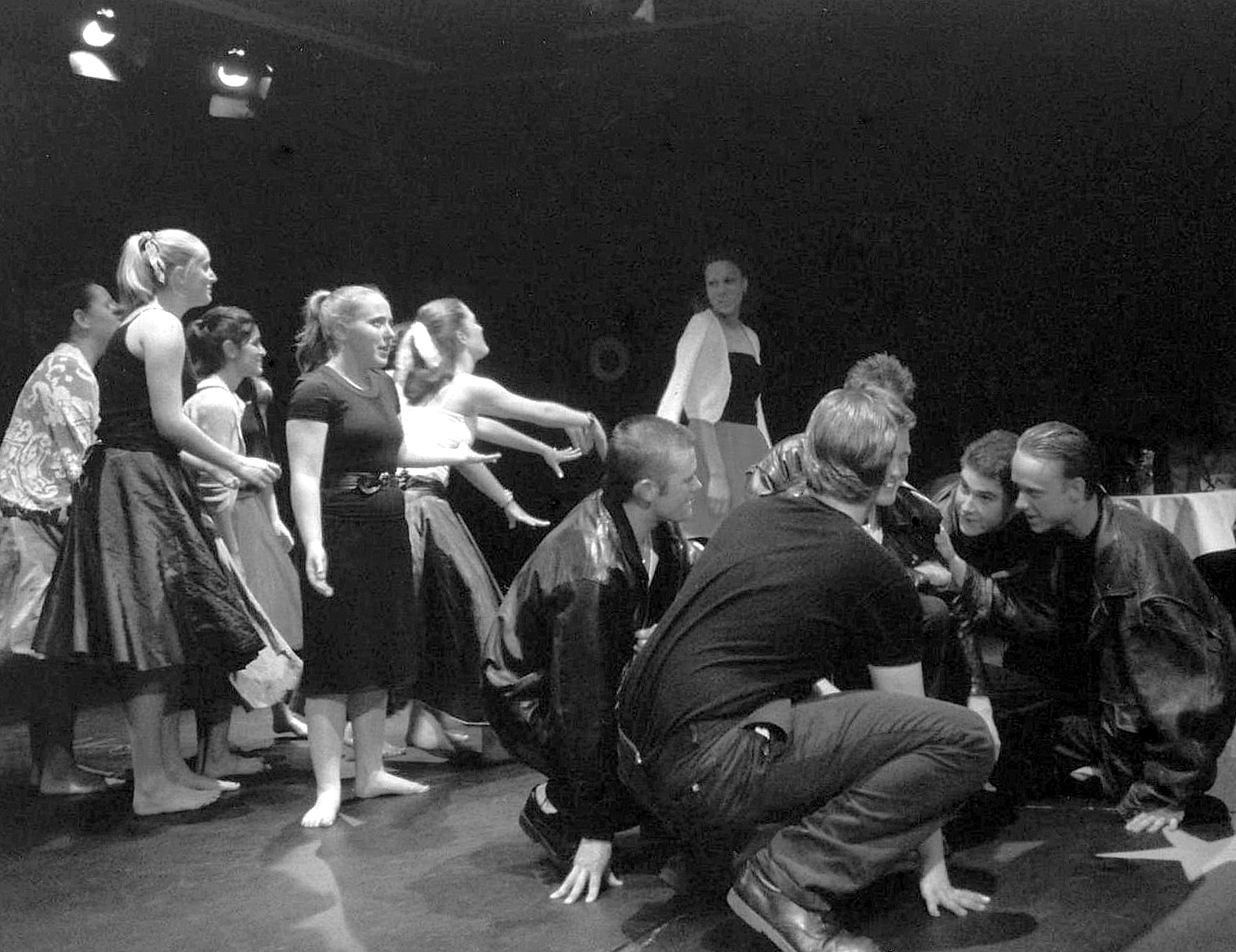 Production of the musical, Cabaret, Kitsilano Secondary, 1999 (Photo from VSB Archives.)
Production of the musical, Cabaret, Kitsilano Secondary, 1999 (Photo from VSB Archives.)
1999-2000
Vancouver School Board Report
Excerpt 1
Excerpt 2
NEWSPAPER ARTICLE
The Vancouver Province, November 17, 2000 Vancouver parents happy at their school’s high rating
by Susan Lazaruk, Staff Reporter
Anamercedes Berkshire was happy to talk about the performance of her son’s East Vancouver school in the province wide 3Rs test as she picked up six-year-old Michael yesterday. Especially after she was told the Vancouver School Board’s school-by-school breakdown showed that her son’s Dr. H.N. MacCorkindale Elementary had an above-average percentage of students who met or exceeded expectations for their grade levels on standardized tests. In writing skills, 98 per cent of its Grade 7 students met or exceeded expectations, which put it in the top 10 schools.
The testing of 150,000 students who were in Grades 4, 7 and 10 last spring, to be presented to parents at school meetings, always come with a disclaimer from educators not to regard the “snapshot” results as the sole indicator of a school’s competence or use them to compare schools. But “numbers count,” says Berkshire. “I’m curious to know the numbers to see if it looks like the teachers are doing their jobs.”
She says she likes the school for other reasons, such as a good playground and staff. Berkshire is particularly pleased with MacCorkindale’s results because the school is in East Vancouver, home to a large number of ESL students, special-needs kids and students from less affluent families. “It has nothing to do with east-side or west-side or anything to do with genes,” said Berkshire, referring to a West Vancouver School Board official who attributed his district’s performance to its “good gene pool.”
MacCorkindale’s parent advisory council president Maryellen Miller, who has two children (in Grades 5 and 7) at the school, also expected the above-average results. “I think it’s everyone, the teachers, the parents and the children, all working together,” she said. Parent Ed Burdge, whose daughter, Veronica, is in Grade 2, said the results are important, but he’s more concerned about gauging his daughter’s performance against other children her age.
Photos from VSB Annual Report 1999-2000.
VSB Central office staff pose outside the new Vancouver School Board Building on West 10th Avenue.
This chapter on the history of the Vancouver School District brings us to the end of the 20th Century. It’s an appropriate place to honour the school buildings selected for full replacement as part of the B.C. Government’s Seismic Mitigation Program. The experiences and memories of thousands of students and VSB staff are tied to these buildings.
The seismic mitigation program has been underway since the early 2000’s, and will continue for many years. Its aim is to ensure the safety of the school population in the event of an earthquake.
For more information about the about the Vancouver School Board’s Seismic Mitigation Program, go to the VSB website and follow these links: Vancouver School Board/Our District/Planning and Facilities/Seismic Mitigation Program.
Bayview Community School
Begbie Elementary School
David Lloyd George Elementary School
Eric Hamber Secondary Secondary School
L’ Ecole Bilingue Elementary School
General Gordon Elementary School
Kitsilano Secondary School
Lord Nelson Elementary School
Maple Grove Elementary School
Sir Sandford Fleming Elementary School
Lord Tennyson Elementary School
Weir Elementary School



